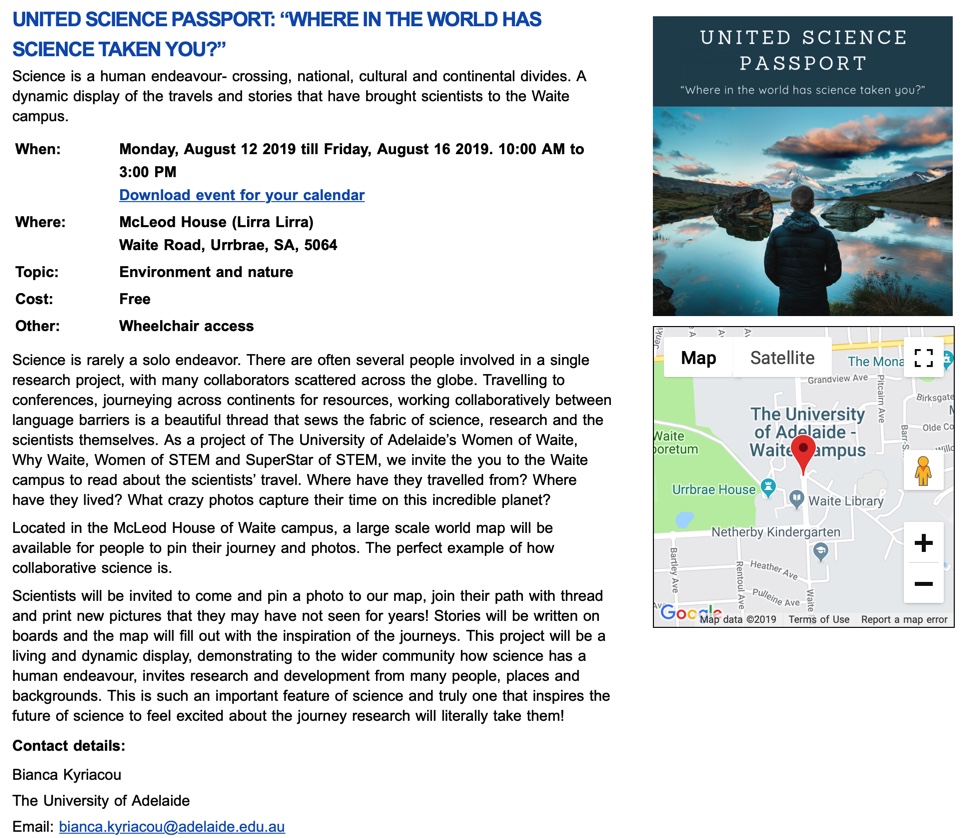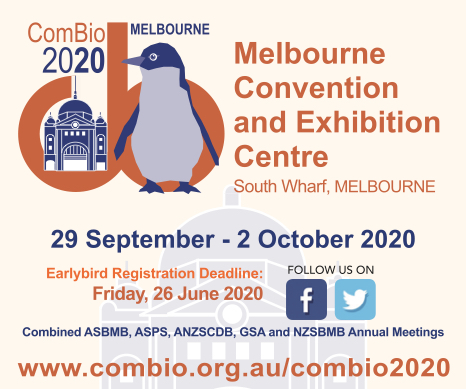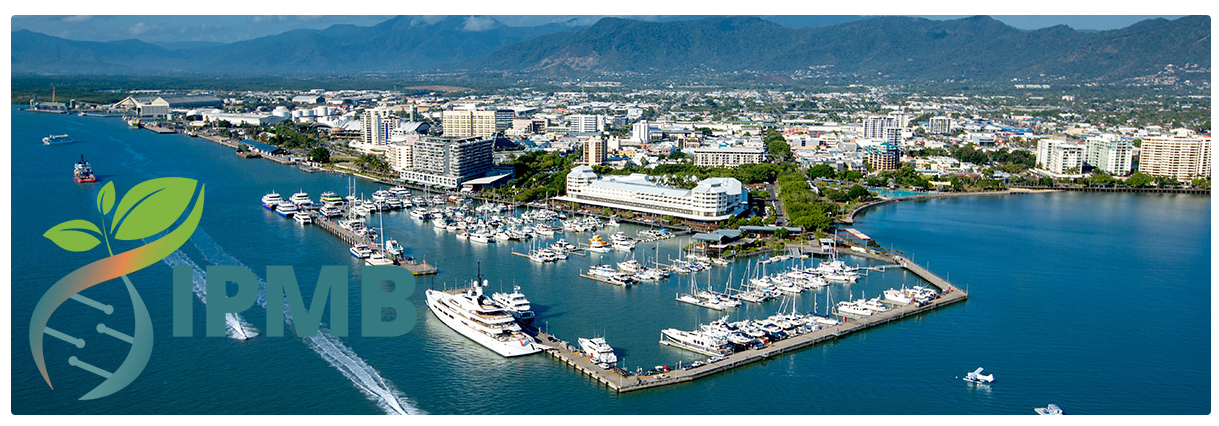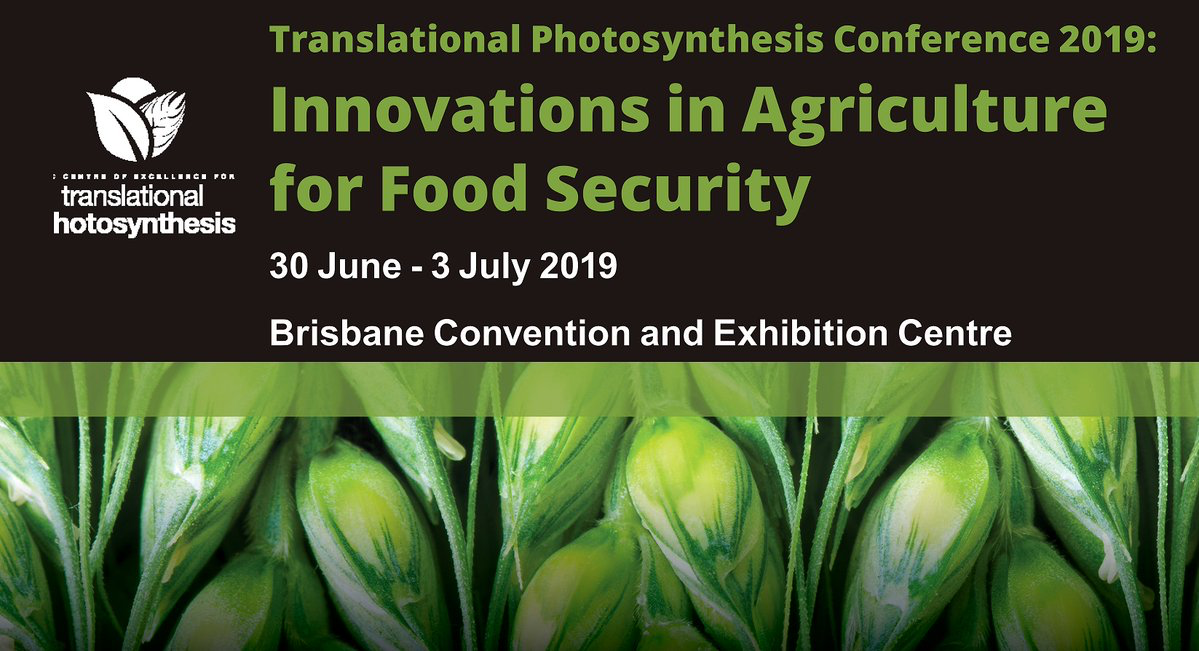- About
- Members
- Join
- Member log in
- Membership Renewal
- Member directory
- Life Members
- ASPS Life Member Professor Graham Farquhar
- ASPS Life Member Associate Professor Hendrik (Hank) Greenway
- ASPS Life Member Dr Marshall (Hal) D Hatch
- ASPS Life Member Dr Paul E Kriedmann
- ASPS Life Member Dr Mervyn Ludlow
- ASPS Life Member Emeritus Professor Rana Munns
- ASPS Life Member Conjoint Professor Christina E Offler
- ASPS Life Member Professor (Charles) Barry Osmond
- ASPS Life Member Emeritus Professor John W Patrick
- ASPS Life Member Dr Joe Wiskich
- Corresponding Members
- Elected Fellows
- Events
- Awards & Funding
- Employment
- Publications
- Research
- Teaching
- Menu
Phytogen-November is ASPS2019 at La Trobe University
10 November 2019
We look forward to seeing you on the 26th November. Follow this link for the schedule.
Below you will read about an upcoming constitutional vote. We want lots of discussion before voting on the day of the AGM (28th November 2019), therefore please join this google group:
https://groups.google.com/d/forum/australian-society-of-plant-scientists
The link will take you to Google Groups. If you have a gmail account, ‘Sign in to view this group’ and then you will be able to post a reply. Otherwise to post, create a gmail account. You can follow steps on this support page for help: https://support.google.com/groups/answer/1067205?hl=en It also details how it is possible to add alternate email addresses if you don’t want to always have to remember a gmail account.
If you wish, you can ‘Subscribe to this group’, you can enter any email address you like, then you will be sent an email for you to confirm your subscription and then you will receive emails when there is activity.
We hope you will join the Google Group to post replies and contribute to discussions related to the ASPS. We also encourage new members and students to participate. If you have difficulties joining the discussion or wish to take up membership, please contact Dr Janet Wheeler (janet.wheeler@latrobe.edu.au) or one of our website and communications team (https://www.asps.org.au/about/website-communications-sub-committee-2)
ASPS AGM and constitutional vote
Dear ASPS members,
The 2019 Australian Society of Plant Scientists Annual General Meeting (AGM) will take place during our annual conference ASPS2019 at 6.00 pm Thursday 28th November 2019 in the Victoria rooms, AgriBio Building, La Trobe University Bundoora, Victoria.
This year at our AGM, I am going to propose a change to the structure of the ASPS committee and Council which will require a change to our Constitution.
I would like to propose that we change from having Discipline Reps to State and Territory-based Reps. As part of this change I would like to propose that a role for the State Reps would be to encourage an informal gathering in their State or Territory, to promote plant science, young scientists and the Society each year. I could envisage that we could provide a small amount of funding each year to the rep to help facilitate this. The process for this can be defined at the AGM.
I am proposing this as I feel that the concept of Discipline-focused reps is somewhat redundant in an era of multi-discipline research. Further, we currently do not have all States represented in our current rep system. For example for 2019, NT, Queensland and Western Australia do not have local ASPS representation. I believe that this change in committee composition would ensure that this lack of representation would not occur and enable ASPS to be promoted more widely, the Society would be more visible and be able to provide more to its members, which in turn would lead to an increase in membership.
Of course we would retain other office bearers such as Plant Science Education and the Student Reps.
To move this process forward we need to change the following item in the Constitution of ASPS Inc;
- THE COMMITTEE
- a. the office bearers of the Society who shall be the office bearers of the Committee;
- where possible other members, each representing a subject discipline or a specific group (e.g.postgraduate students). The subject disciplines shall encompass the broad spectrum of the society’s scientific and educational interests together with due regard for each State and Territory being represented.
So I am proposing that Item 21 in the constitution be reworded to the following where I have marked in bold the change in text;
- THE COMMITTEE
- a. the office bearers of the Society who shall be the office bearers of the Committee;
- where possible other members, each representing a State or Territory of Australia or a specific group (e.g.postgraduate students). The subject disciplines shall encompass the broad spectrum of the society’s scientific and educational interests together with due regard for each State and Territory being represented.
This can only be done via the following process as outlined in the Constitution;
- ALTERATIONS TO THE CONSTITUTION
This Constitution may be altered or amended a. by resolution at an Annual General Meeting, provided that all members have the opportunity to vote by post or by proxy and b. the resolution is passed by at least a two thirds majority of financial members voting.
So, this will be an item at the AGM to be held during ASPS 2019. As not all members are attending this meeting or the AGM, we have organised an online voting system which will be open before the AGM (to be held on 28th November 2019) and close the morning of that day. Further we will have open a discussion forum, so that members can voice their opinion about the proposed resolution and others can view it if the wish.
If the Society wishes to accept this change, then I suggest that we keep the two systems running through 2020 or until the end of any Discipline Reps term and for 2020 we find people to nominate as reps in the States and Territories where ASPS is not currently represented.
I hope that you, as a financial member of ASPS Inc., will take the time to consider this and vote as we need 2/3 of financial members to approve it before we can move forward.
Details on voting including a link will be e-mailed through to you in the coming week.
Kathleen Soole
President – Australian Society of Plant Scientists (www.asps.org.au)
October 2019 Phytogen
19 October 2019
Welcome to October Phytogen. Hope you are making preparations towards our meeting in November. You can still register, use this link: https://www.asps.org.au/combio/asps-2019/about-asps-2019 Well, it has been our 60th year and Professor Roslyn Gleadow (@RosGleadow) from Monash University has written a reflection for us. Roslyn will be delivering the JG Wood lecture on Thursday 28th November. View the draft ASPS2019 program HERE
Reflection by Roslyn
Kingsley Rowan, my MSc supervisor, was a founding member of ASPP (as it was then). He walked into my office one day and said: “You should join the Society — and subscribe to the journal too.” (referring to the Australian Journal of Plant physiology, now Functional Plant Biology). So, I did. I’ve been a member ever since, even when I was out of research when I had my kids. I dropped getting the journal when I got a job working for Editor-in -Chief Laurie Martinelli as a copy editor for a while, but it’s still on my regular reading list.
People often wonder what is the point in joining professional societies? One important reason is that it provides a respectable, identifiable organisation for journalists to contact, and you can’t have a society without members. When I was President I often got calls from the media (e.g. the ABC, SBS, The Age etc.) to provide expert commentary on various things relevant to plants, GMOs, climate change and so on. This is really, really important. Even more so now with all the crazy ideas out there in internet-land. I am now President of the Global Plant Council (of which ASPS is a member organisation) and we are aiming to be a reliable point of contact for media and policy makers at the international level.
I believe there is strength from being part of professional societies such as ASPS. I’ve been a regular ASPS/ComBio attendee and enjoy the way these conferences stretch me beyond my comfort zone and force me to think about things outside my own immediate field. The national-scale networking is also invaluable. I couldn’t travel overseas for what seems like decades when my children were growing up (plus the money issue, or lack thereof). Going to the annual meetings was my only option. I often only went for 2 days, timed to coincide with particular international speakers (who I made sure I met) and the annual society dinner, which was always fun. I organised that one year, so I know how much work it is herding cats, but well worth it. The contacts with leading national and international scientists have stood me in good stead – I have had long standing collaborations with several of them ever since.
 There was a seismic shift in plant physiology in the 80s and 90s with the enormously valuable input from molecular biology. This created a dilemma: should we join with the ASBMB and ANZSCDB as ‘ComBio’ or go it alone? The advantage of having a combined meeting is that there is a lot of overlap and people will only generally go to one generalist, national meeting. Also, being a bigger meeting, the trade fair is bigger, and ASPS receives important income from that. The downside is that we have to work hard to keep our identity, especially we ecophysiologists[1]. The new system of alternating a plant-focussed meeting with ComBio seems like an excellent solution and hats off to the Council who agreed to do this.
There was a seismic shift in plant physiology in the 80s and 90s with the enormously valuable input from molecular biology. This created a dilemma: should we join with the ASBMB and ANZSCDB as ‘ComBio’ or go it alone? The advantage of having a combined meeting is that there is a lot of overlap and people will only generally go to one generalist, national meeting. Also, being a bigger meeting, the trade fair is bigger, and ASPS receives important income from that. The downside is that we have to work hard to keep our identity, especially we ecophysiologists[1]. The new system of alternating a plant-focussed meeting with ComBio seems like an excellent solution and hats off to the Council who agreed to do this.
Next month is the first of the new-look ASPS meetings. Last time I went to ASPS at La Trobe it was on at the same time as ASBMB, which was in downtown Melbourne, and people were racing between the two by car. Crazy! I encourage you to come and learn stuff, give back, participate in some informal mentoring and make some life-long friends.
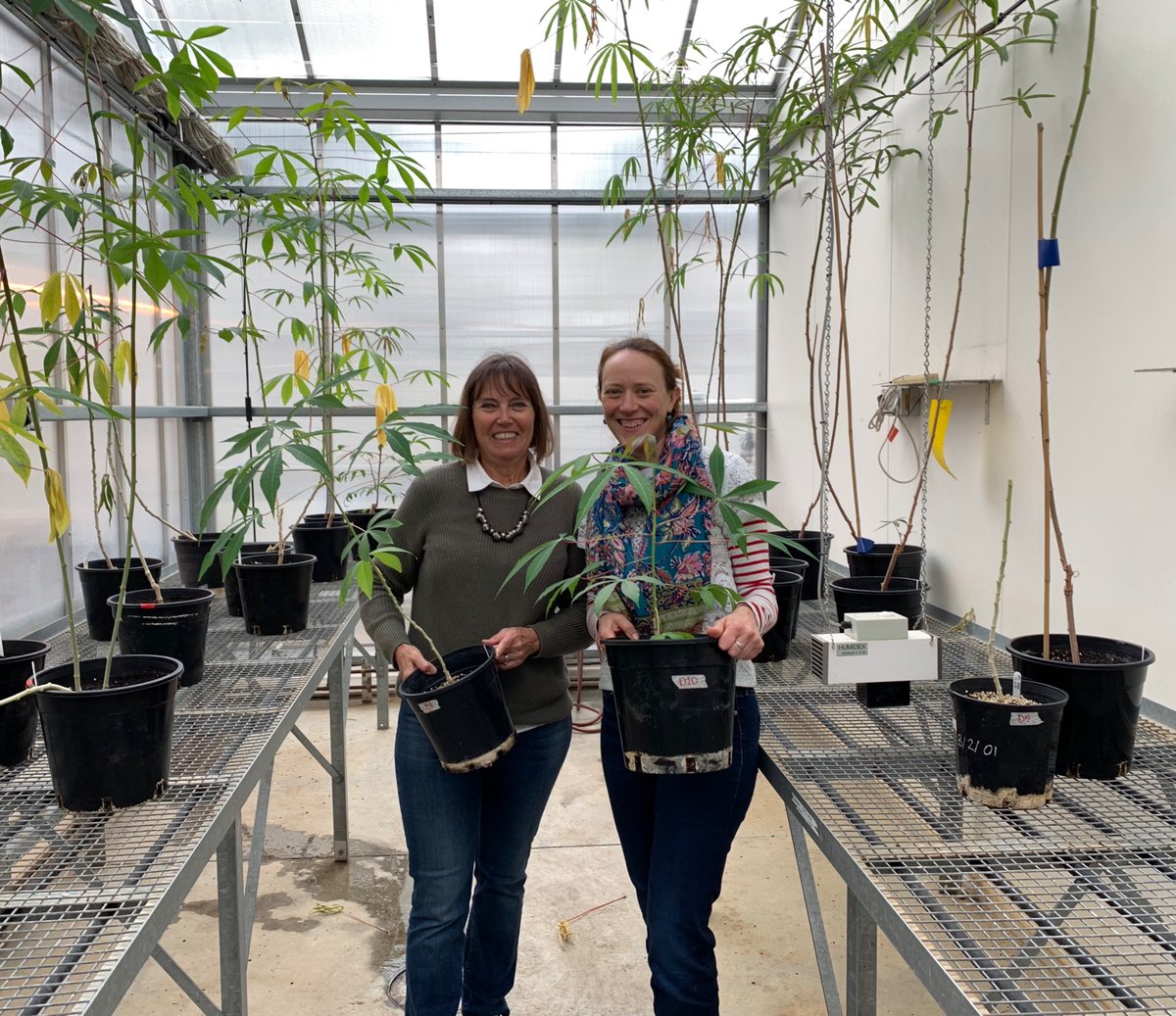
Prof Ros Gleadow, President ASPS 2010-2012 with cassava varieties and Bec Miller from University of Melbourne.
[1] The satellite “EcoFizz” meetings started by Susanne Schmidt, Mark Hovenden and me, and followed by Oula Ghanoum and David Tissue were great – does someone want to start those again?
Science meets Parliament is designed to bring together decision makers and Australia’s leading STEM professionals, to promote the role of science, technology, engineering and mathematics – and the valuable part these sectors can play in politics.
This will be the 20th year and ASPS will be represented by Tracey Cuin and Ricky Milne
You might remember an inquiry has been launched by the Standing Committee on Agriculture and Water Resources. It is of particular interest to members of ASPS and Tracey Cuin and Mike Haydon are preparing a submission. The link information for the inquiry can be found here and submissions close Thursday 28th November.
If you haven’t managed to send suggestions to the ASPS secretary Vanessa Melino (vanessa.melino@unimelb.edu.au) have a go now. This is a great opportunity for us to drive policy. I was at a workshop last week where it became evident how important this is. It it is for us to come up with clear policy with your suggestions of key priorities for plant/agricultural sciences in relation to the terms of reference: “The Committee will inquire into and report on, the opportunities and impediments to the primary production sectors realising their ambition to achieve a combined $100 billion value of production by 2030.” You also might find it interesting to read this discussion paper. 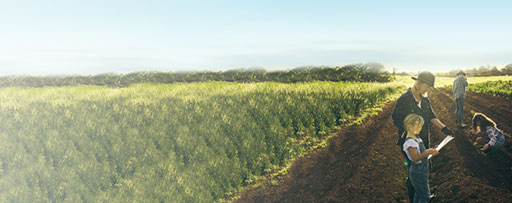 Image courtesy of KPMG
Image courtesy of KPMG
Celebration of Professor Sally Smith
A reminder there will be a gathering on October 25th 2019 to celebrate the life of Professor Sally Smith a long-standing member of ASPS who passed away suddenly on 13 September 2019.
Sally was Emeritus Professor in the School of Agriculture, Food and Wine, University of Adelaide. She was also Honorary Professor at the China Agricultural University and the Chinese Academy of Sciences.
Sally was a world authority on the mycorrhizal symbiosis between plants and fungi. She made outstanding contributions to our understanding of the structure of the plant-fungal interface, of nutrient transfer across it and of the molecular processes involved in forming and controlling the interface.
Sally completed her BA and PhD at Cambridge (1965) and her DSc at the University of Adelaide (1991). She held a personal Chair in Soil Science (1995) and was Director of the Centre for Plant Root Symbioses (1998). She was elected to the Australian Academy of Science in 2001. Just two months ago, Sally obtained an inaugural ‘Eminent Researcher’ award from the International Mycorrhiza Society. To celebrate her life there will be a gathering at Adelaide University’s Waite Institute, Beltana Café, McLeod House on the University of Adelaide Waite Campus, at 4pm on 25 October 2019. For further details and to RSVP please use this link. If you would like to share information, photos or memories as part of our ASPS tribute for Sally, please share these with Dr Stephanie Watts-Williams (stephanie.watts-williams@adelaide.edu.au), who is kindly leading our creation of an ASPS tribute.
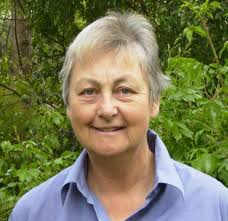
Phytogen – September 2019
10 September 2019
Welcome to Phytogen for September 2019. It is getting closer to our annual meeting. A draft timetable can be viewed on the ASPS2019 website. Abstracts for posters (only) are still open until 30th September. Registration is still open until then too. You can register and submit your poster abstracts by clicking on this link. We look forward to seeing you in November. It will be a busy month for science as Science meets Parliament will also be occurring.
Science meets Parliament is designed to bring together decision makers and Australia’s leading STEM professionals, to promote the role of science, technology, engineering and mathematics – and the valuable part these sectors can play in politics.
This will be the 20th year and ASPS will be represented by Tracey Cuin and Ricky Milne. Tracey works at the University of Tasmania. She is researching action potential signals through plants. Fast responses to an external threat depend on the rapid transmission of signals. Ricky works at CSIRO Agriculture and Food, Canberra. He is researching resistance to fungal pathogens, and exploiting the transferability of this resistance to other economically important crops. Fungal diseases such as rust pose a constant threat to global grain production.
Each year more than 200 scientists, technologists and STEM professionals take part in this unique event over two very full days. On Day One delegates hear from leaders in policy; media; science and technology; and advocacy. They share their rich insights through panel discussions, presentations and workshops. Day One then concludes with a Gala Dinner which traditionally sees the Prime Minister and Opposition Leader present their position and plans for science, technology and innovation in Australia.
On Day Two, delegates meet face-to-face with Parliamentarians across the political spectrum. It’s a chance for scientists and technologists to share their enthusiasm for science and information about their work and discipline. This is a rare opportunity to speak directly to politicians and is the highlight for most who attend. Delegates will also have the chance to be part of the live audience for the National Press Club Address and to attend a session of Parliamentary Question Time. Additionally, delegates get ample opportunities to meet other men and women working in STEM – from early career researchers through to senior decision-makers. Below are reports from Janet Wheeler, La Trobe University and Mike Haydon, Melbourne University who attended in 2018.
Janet: In Feb 2018 I represented ASPS at Science meets Parlianment. It was a whirlwind 2 days with plenty of networking, seminars, workshops, meetings and photo opportunities.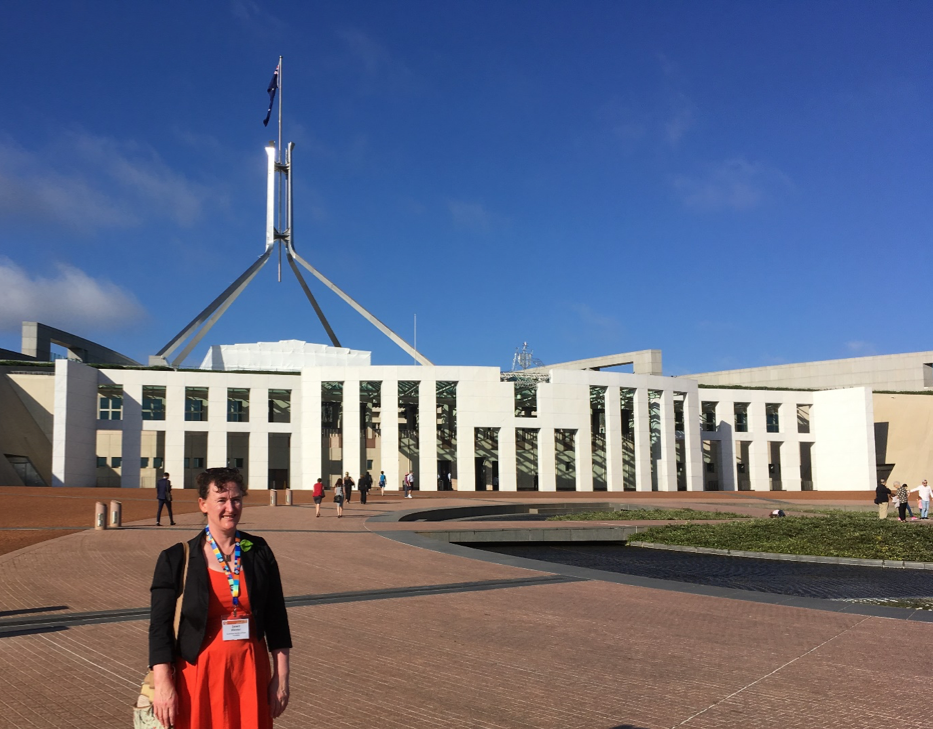
The first day was spent at the National Gallery where we heard from Dr Cathy Foley, CSIRO Chief Scientist who highlighted the responsibility we have to ensure our elected leaders have the opportunity to access our expertise. Science and technology effect the available solutions. Dr Foley also shared advice on how to hone your pitch and shape the discussions we would be having the following day with members of parliament.
The next morning we made our way through security at Parliament House and saw “Chuck the shrimp” embeded in the foyer floor. 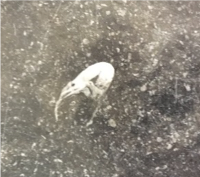 I met with Graham Perrett Federal Member for Moreton (Qld) and highlighted the significant contribution plants make to the Australian ecomomy and contibution plant science makes to current and future challenges.
I met with Graham Perrett Federal Member for Moreton (Qld) and highlighted the significant contribution plants make to the Australian ecomomy and contibution plant science makes to current and future challenges.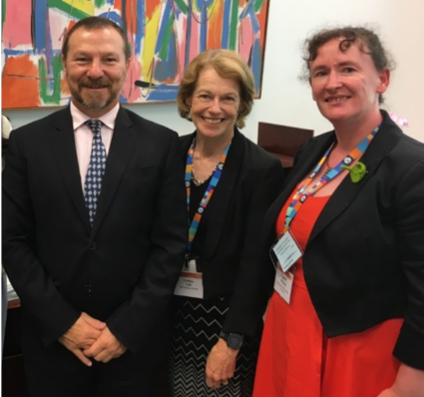
Another highlight for me was seeing Question Time in person. It happened to be an exciting day as Barnaby Joyce was a day or so away from steping down as Deputy Prime Minister. So theatrical.
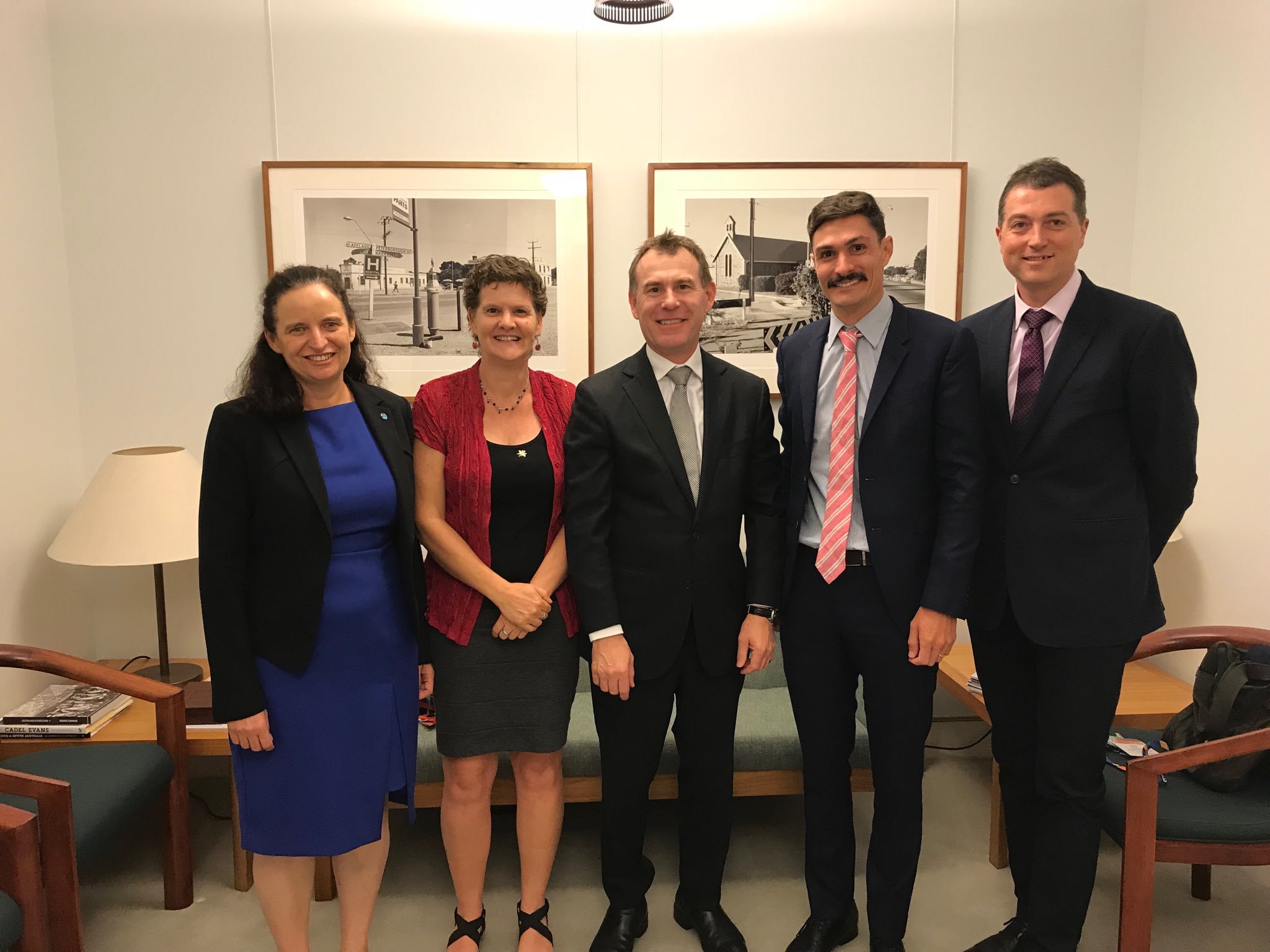
Mike Haydon (second from right) with Nick Champion (middle) and Rachel Burton (second from left).
Mike: I had the pleasure of representing the ASPS as a delegate at Science meets Parliament in February 2018, a major annual event organised by Science and Technology Australia. I enjoy the circus that is Australian politics and so it was quite a thrill to get some insight into the ‘Canberra bubble’. The first day was at the National Gallery of Australia and included talks, networking and panel discussions on science policy and engagement, involving our Chief Scientist, prominent science communicators and experienced lobbyists. In the evening, we attended the Gala Dinner in the Great Hall in Parliament House, where we mixed with MPs and were addressed by the then Opposition Leader, Bill Shorten, and the Minister for Jobs and Innovation, Michaelia Cash. This was before the infamous whiteboard incident and subsequent controversies.
On day two we attended Parliament House. There was a program of presentations from parliamentary science advocates including Kim Carr, Adam Bandt, Karen Andrews and Richard Marles, each making promises about supporting science. The major feature of SmP is the opportunity to meet with Parliamentarians in small groups. Together with Rachel Burton, I spent a relaxed 30 minutes with Nick Champion, the Assistant Shadow Minister for Science. We enjoyed lunch at the National Press Club, during which we were passionately addressed by Emma Johnson, the Presidentof STA, about the importance of supporting Australian science. In the afternoon, we were entertained by the interrogation of Barnaby Joyce during Question Time over his living arrangements.
I greatly valued the opportunity to attend SmP on behalf of ASPS. It provided a new perspective on how to contribute to science policy, presented novel networking opportunities and was a great experience to be inside The House.
To finish, have a look at #tsbakeoff and @TSCommissioner for Australia’s threatened species of plants and animals.
Phytogen – August 2019 Where in the World has Science taken you?
14 August 2019
It is National Science Week this week. 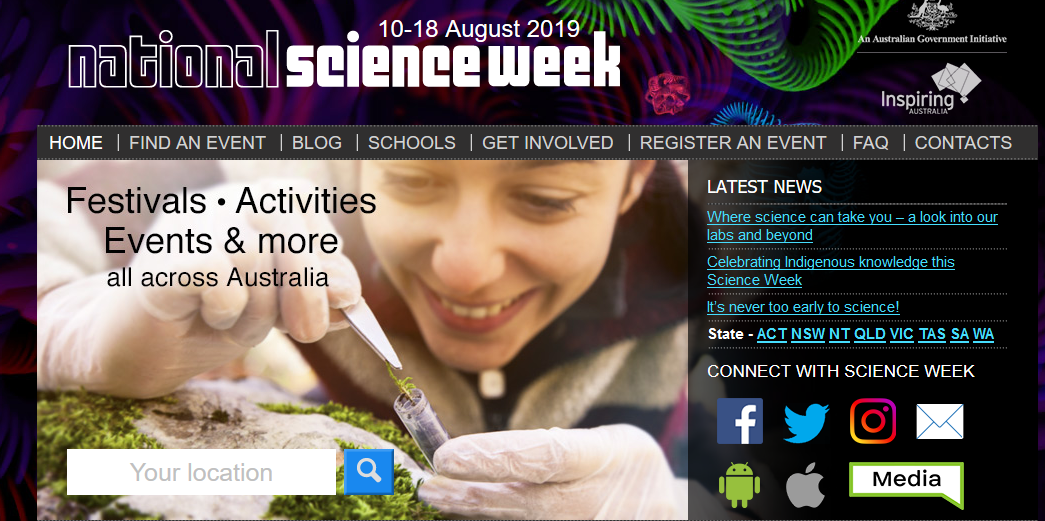 Taking a look at the events got me thinking about how amazing our peer networks and our travels have been. In particular, I draw your attention to an event occurring at Adelaide University
Taking a look at the events got me thinking about how amazing our peer networks and our travels have been. In particular, I draw your attention to an event occurring at Adelaide University
Even though you all won’t be able to make it to Adelaide this week, the theme of global peer networks is evident in this report by John Evans reflecting on this years Translational Photosynthesis Conference.
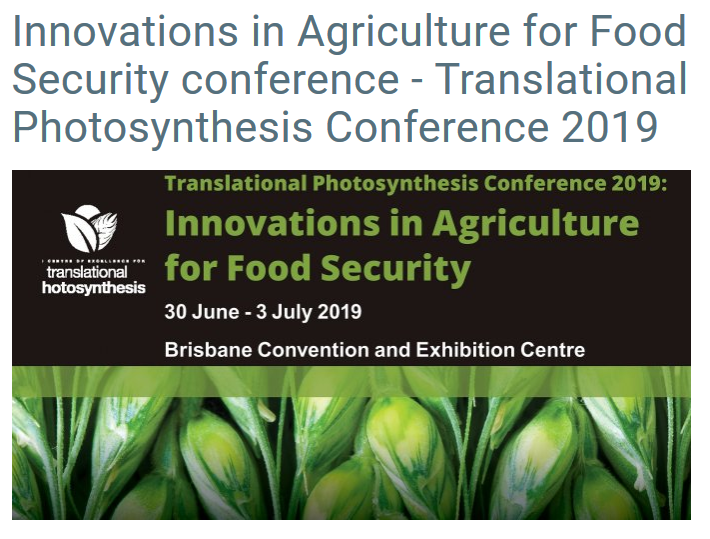
Report on the conference Innovations in Agriculture for Food Security
by John Evans
ASPS was one of the sponsors of this conference that was held at the Brisbane Convention and Exhibition Centre (30 June – 3 July). Over 100 people attended, including Professor Susanne Schmidt and Sana Khan from UQ who represented ASPS. To promote ASPS, a beautiful banner was designed and displayed.
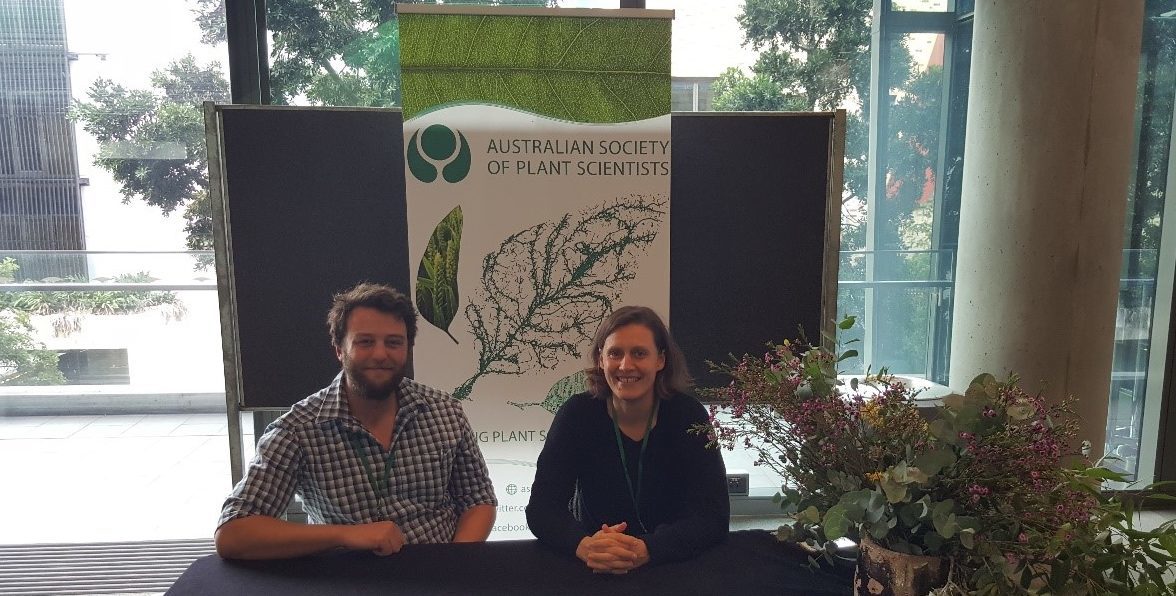
Tam Salter and Caitlin Byrt sat in front of the ASPS banner they designed.
Attendees came from the UK, Germany, Canada, USA, China, the Philippines, Czech Republic, Australia and NZ. One aim of the meeting was to raise awareness of the broader context within which researchers work. Establishing contacts and a network of people can be of great benefit to science and careers, so the meeting began on the Sunday evening with a forum for the next generation, organised by Alex Wu. Plenty of time was allocated to the morning and afternoon poster sessions. Preceding these sessions, poster presenters introduced themselves in flash talks to encourage people to come and discuss their work. It was clear from the animated groups, that these opportunities were well used. The ECR (usually early career researcher) acronym was redefined by Barry Osmond to include end of career, but his enthusiasm for espousing the possibilities of LIFT (laser induced fluorescence transient) method, clearly showed he is embarking on yet another research phase. By contrast, Graham Farquhar regaled us over the conference dinner with how many times during his early career his next step was only made possible by personal recommendations rather than from an excellent academic record. Metrics and regulation are the current challenges that need to be mastered by us all if we want to achieve career and food security.

Graham Farquhar recounting his early career as the ferris wheel spun behind him during the conference dinner (Photo by Natalia Bateman)
Raj Bhula, from OGTR (Office of the Gene Technology Regulator; Australian Government), explained the current state of Australian regulation for genetic modification of organisms. It is important that ASPS members take the opportunity to submit responses to enquiries over future changes to regulation so that the voice of scientific practitioners can be heard and counter activist groups that are opposed to GMOs. This is particularly pertinent for the rapidly emerging capability offered by CRISPR cas9.
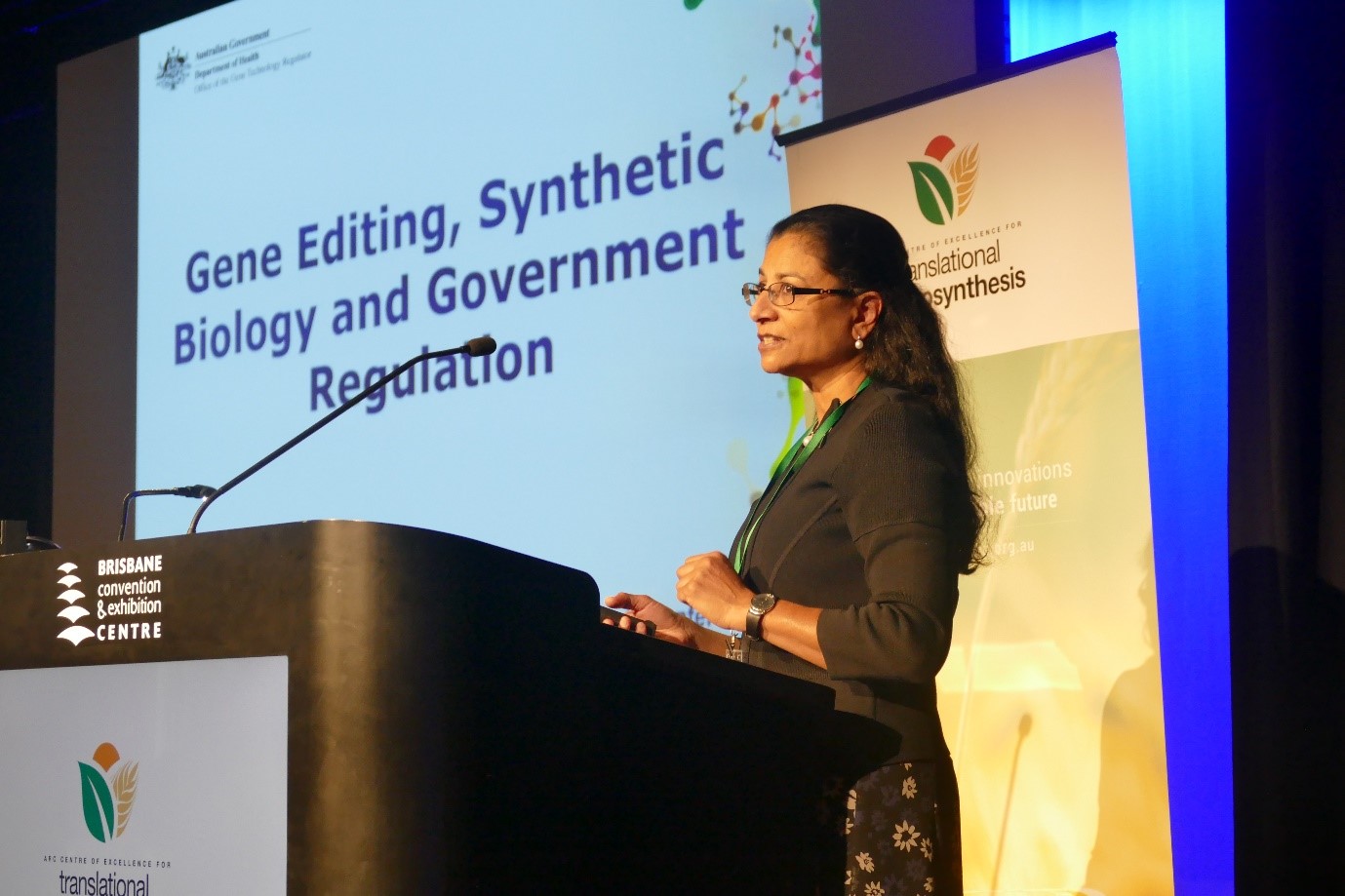
Dr Raj Bhula, from Australia’s Office of Gene technology regulator (OGTR), delivering her keynote address (Photo by Natalia Bateman)
One final highlight was the keynote talk from Mark Stitt who reminded us of the problems we cause plants when growing them in square wave controlled environments. Turning the light on and off abruptly rather than gentle light transitions through natural dawn and dusk plays havoc with gene expression and presumably disrupts plant physiology.
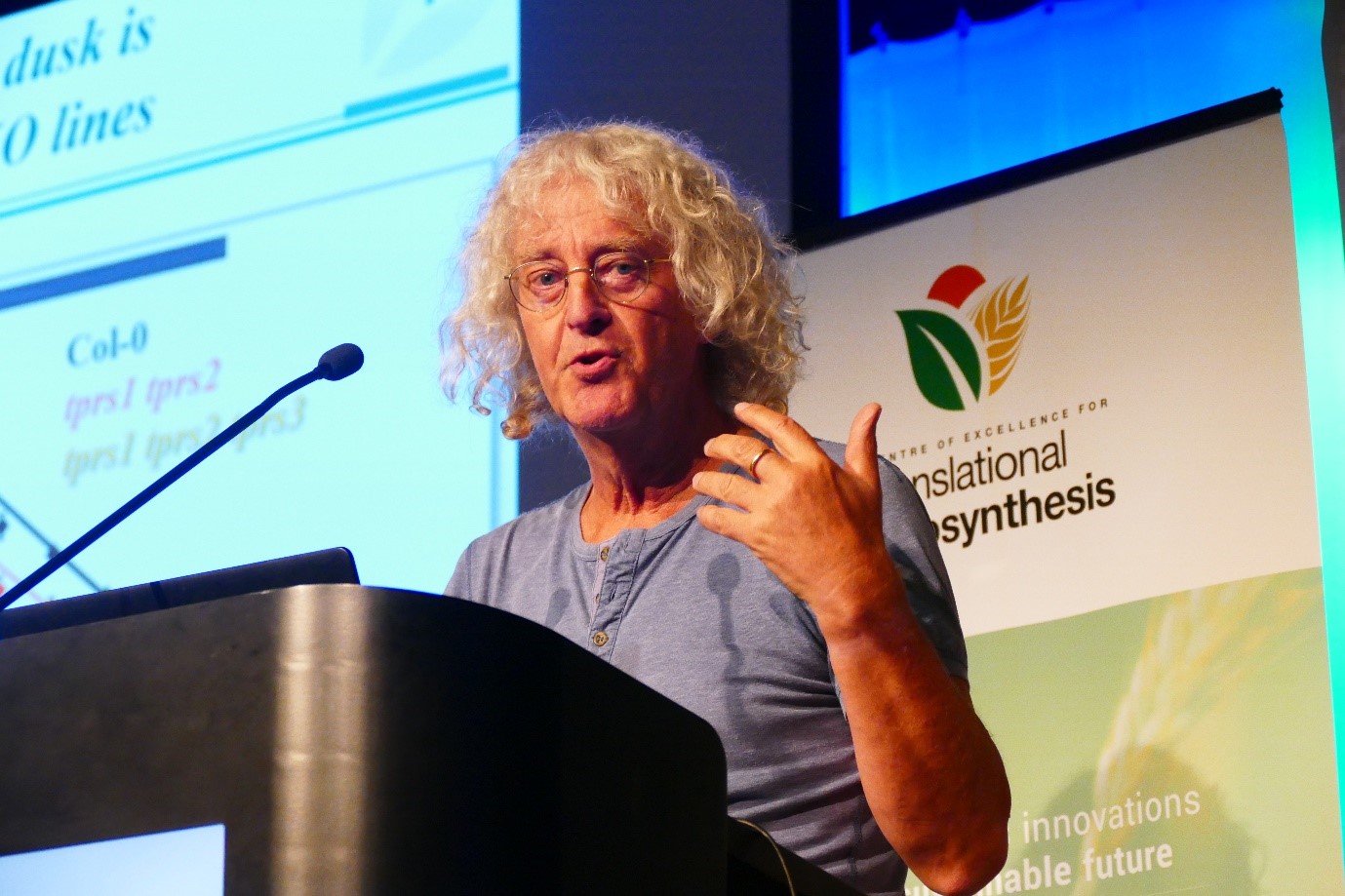
Mark Stitt delivering his keynote address (Photo by Natalia Bateman)
Lastly, here is a report from one of our RN Robertson Travel Fellowship awardees. Carolyn Vlasveld from Monash University visited the University of Tasmania in May-Jun 2019.
RN Robertson Travelling Fellowship Report
by Carolyn Vlasveld
My PhD involves understanding differences between the leaves of juvenile and adult eucalypts. Working on this has led me towards studying juvenile-adult differences from the context of leaf hydraulic function. Consequently, the more discussion I had with my supervisors, the more it became apparent that I should investigate differences in leaf physiological traits. But my knowledge at the time entailed more about the ecology of morphological traits – I had little understanding of leaf physiology and measuring physiological traits.
This led me to visit Tim Brodribb’s laboratory at the University of Tasmania (UTAS) with the help of the RN Robertson Travelling Fellowship. A major focus of their work is the evolution of leaf physiological traits fundamental to hydraulic function. They had recently found differences in xylem vulnerability between the juvenile and adult leaves of Eucalyptus globulus (Lucani et al. 2019), using their novel optical vulnerability (OV) method. They suggested that I learn this method because it is often simpler than previous methods for measuring xylem vulnerability.
My visit focused on learning the OV method, among other techniques important to my thesis, such as preparing stained leaf samples for viewing anatomical structures. I measured the leaf xylem vulnerability of Eucalyptus globulus trees growing at the UTAS campus. The OV method involves measuring water potential and cumulative embolisms over time by using an optical camera. The camera detects embolism events by taking a time-lapse series of images of a dehydrating leaf. Light is transmitted through the leaf blade for each photograph. After xylem conduits embolise, they transmit less light through the leaf. Consequently, the occurrence of an embolism is detected by the light difference between two sequential images in the time-lapse. These embolism occurrences are later isolated and translated from the images to quantify cumulative embolisms as leaf water potential decreases over time.
A 3D-printed clamp containing the camera is secured over a dehydrating leaf, which encloses a section of the blade to prevent the entry of outside light. The camera connects to a raspberry pi computer, which programs the process of taking sequential photographs. Meanwhile I also learnt to use a Scholander pressure bomb and psychrometer to measure water potential.
This method will be used in my thesis to compare xylem vulnerability in other species occurring in different environments, and I wish to stay in contact with those at UTAS through this process.
I loved staying in Hobart and winter was a perfect time to visit – I caught the Pint of Science at Shambles Brewery, the view of snowy Mount Wellington from the city, and the UTAS School of Biological Sciences’ famous “Crib Night” where everyone dresses up to have a cribbage tournament.
Thank you very much to the Australian Society of Plant Scientists, the RN Robertson Fund, and the University of Western Australia for helping me take this trip. Thank you also to Tim Brodribb and others in his laboratory for making me feel welcome and sharing their skills and knowledge. This visit enriched my experience as a PhD student in addition to learning new techniques required for my thesis and increasing my understanding of leaf hydraulic function.
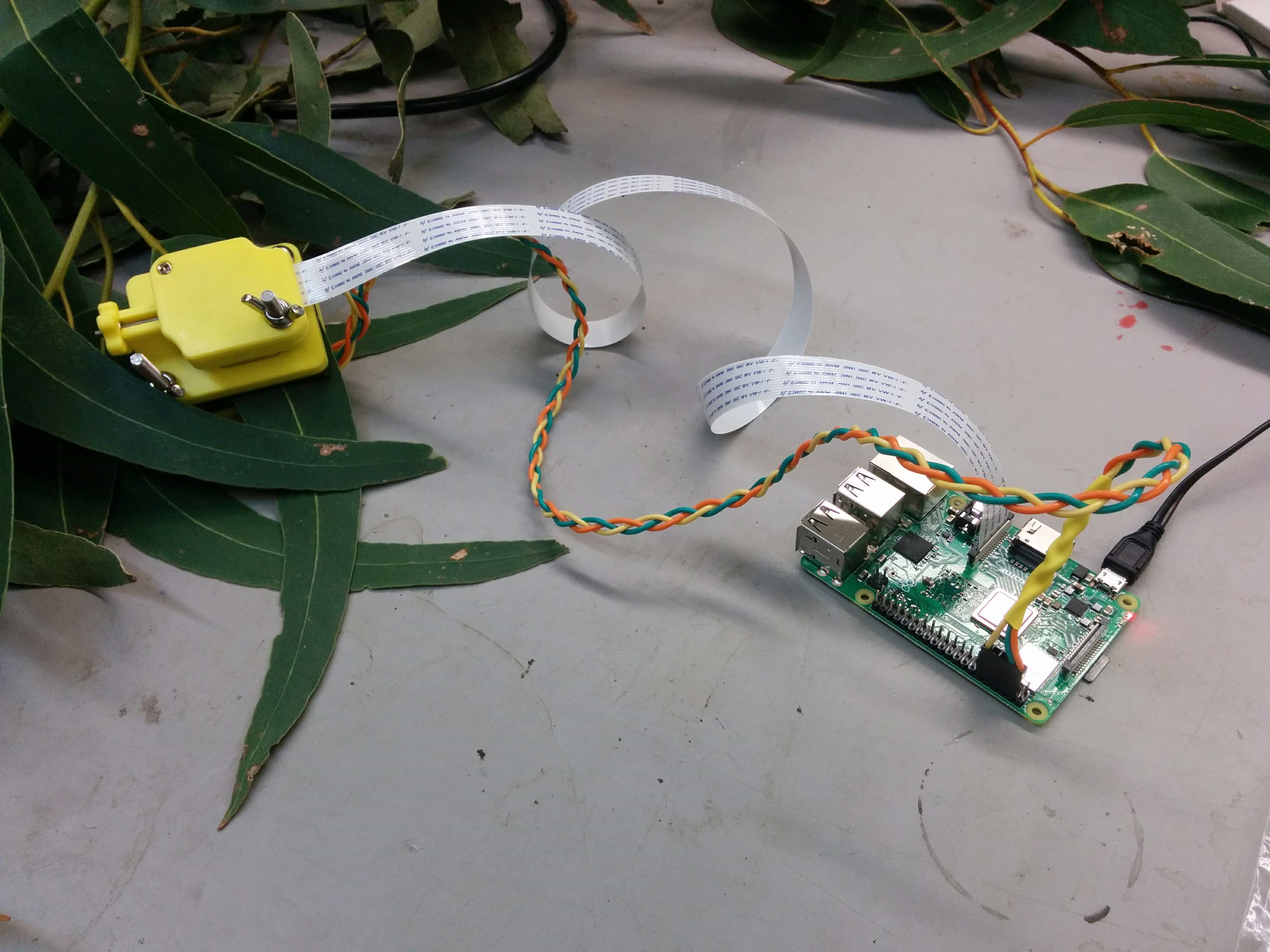
3D-printed leaf clamp containing a time-lapse camera (left) which connects to a raspberry pi computer (right)
References
Lucani CJ Brodribb TJ, Jordan GJ & Mitchell PJ (2019) Juvenile and adult leaves of heteroblastic Eucalyptus globulus vary in xylem vulnerability. Trees 1-12.
I hope you will be able to finish off the week attending a science event near you or catching up with your peers and their travels at an upcoming meeting, many are listed on our website (upcoming events/add an event page under the events tab) and you can add events…….. Next month will be reports from Science Meets Parliament.
| ASPS 2019 to be held 26-29th November 2019 is an event not to be missed! It will bring together plant scientists from across Australia and will be held at AgriBio, La Trobe University, Melbourne. |
| In 2020, |
| In 2021,
the 13th International Congress on Plant Molecular Biology will be in Cairns, Australia |
Phytogen – July 2019 Blast-off!
21 July 2019
Now we are past the middle of the year and to think, 50 years ago today astronauts were walking on the moon. I hope over the next few weeks you will marvel at the stars and this may inspire you in your current pursuits.

In our July issue, we recognise two Award Recipients, Dr Caitlin Byrt and Associate Professor Sigfredo Fuentes. Caitlin Byrt is a bright emerging researcher awarded the Peter Goldacre Award in 2018. I always remember from seeing her talk the multitude of collaborators she acknowledged. It demonstrated a vibrant global community supporting her to reach for the stars and tackle the grand challenge of maximising plant yields.
In Melbourne this year, we can look forward to hearing from the 2019 award recipient, Simon Williams from the Australian National University.
Peter Goldacre was a foundation member of ASPP, and an enthusiastic supporter of the Society from its inception. With a Science Degree from the University of Sydney, majoring in chemistry and biochemistry, he took up a research position at what was then the CSIR Division of Plant Industry in Canberra in 1947. Peter was an enthusiastic researcher who was held in great respect by his peers. His tragic death in 1960 from stomach cancer at age 34 shocked and saddened all his friends and colleagues. The Goldacre Medal was subsequently established as a lasting tribute to his contributions in plant physiology, and as an encouragement to young researchers. Functional Plant Biology now sponsors the Goldacre Award. The Award is made on the merit of original research in one area, the findings of which have been published, or accepted for publication, in the three years preceding the year of the Award. The work should have been done within 10 years of the candidate submitting their PhD.
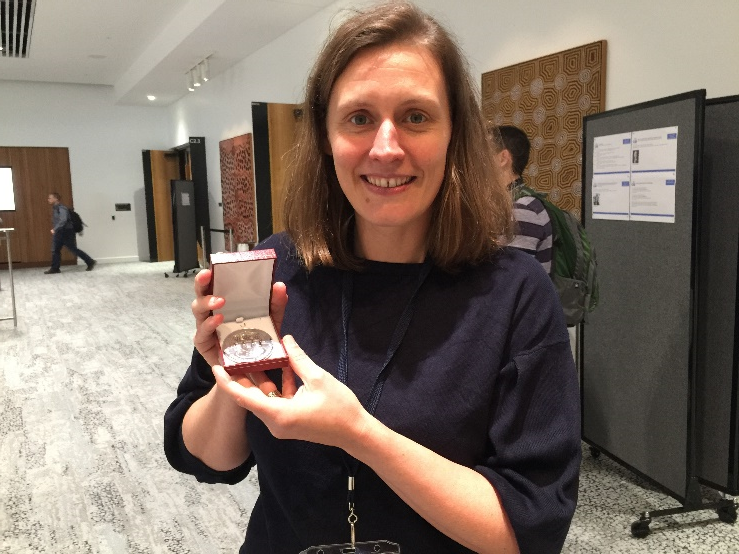 The recipient of the 2018 Goldacre Award, Dr Caitlin Byrt (University of Adelaide, now Australian National University) for her work on studying membrane transporters towards enhancing crop yields.
The recipient of the 2018 Goldacre Award, Dr Caitlin Byrt (University of Adelaide, now Australian National University) for her work on studying membrane transporters towards enhancing crop yields.
ComBio 2018 Peter Goldacre Lecture Abstract
CELL MEMBRANE WATER CHANNELS WITH BUILT IN ION CHANNELS
Byrt C.S.1, 2, Qiu J.1, 2, McGaughey S.1, 2, Groszmann M. 3, 4, Bose J.1, 2 and Tyerman S.D.1, 2
1The University of Adelaide. 2ARC Centre of Excellence in Plant Energy Biology. 3 Australian National University. 4 ARC Centre of Excellence for Translational Photosynthesis
Cell function is dependent on maintenance of water and ionic homeostasis. Aquaporins are regulated by cells to achieve water homeostasis, but in addition they may also be required for ion homeostasis. Cell water permeability is determined by the water conductance and density of aquaporins present in the plasma membrane. Plants express in the order of 30 to 70 different types of aquaporins, depending on the plant species, and these include a group called PIPs that are particularly abundant in plasma membranes. PIPs generally form tetramers with each monomer capable of allowing the passage of water. There are subsets of PIP tetramers that allow passage of other solutes, and we have identified PIPs that can change between functioning as water channels and non-selective cation channels (NSCCs) when expressed in heterologous systems. In plants there are likely to be multiple types of NSCCs and previous studies have revealed that NSCCs, for which the molecular candidates are so far unidentified, can provide a pathway for nutrient transport, and also for sodium transport under salinity stress. PIPs functioning as ion channels can allow passage of sodium and potassium, and they share similar properties with previously reported NSCCs. For example, NSCC and PIP ionic conductance are sensitive to calcium, pH and cyclic nucleotides. We are testing whether PIPs can account for any of the previously observed NSCC functions in plants by studying ion transport traits in mutant and transgenic lines of Arabidopsis where the PIPs of interest are either knocked out, overexpressed or mutated to change their ion channel function. Testing whether PIPs are implicated in maintaining water and ionic homeostasis in plants is an important step towards resolving the roles of PIPs in plant tolerance to dry, saline and nutrient deficient environments.
https://onlinelibrary.wiley.com/doi/full/10.1111/pce.12832
|
The aquaporin AtPIP2;1 is an abundant plasma membrane intrinsic protein in Arabidopsis thaliana that is implicated in stomatal closure, and is highly expressed in plasma membranes of root epidermal cells. When expressed in Xenopus laevis oocytes, AtPIP2;1 increased water permeability and induced a non‐selective cation conductance mainly associated with Na +.
onlinelibrary.wiley.com
|
For: Byrt, C.S., Zhao, M., Kourghi, M., Bose, J., Henderson, S.W., Qiu, J., Gilliham, M., Schultz, C., Schwarz, M., Ramesh, S.A. and Yool, A., 2017. Non‐selective cation channel activity of aquaporin AtPIP2; 1 regulated by Ca2+ and pH. Plant, cell & environment, 40(6), pp.802-815.
Next, Associate Professor Sigfredo Fuentes is awarded the Plant Science Teaching Prize for Plant Physiology. We will look forward to hearing from him at ASPS2019 at La Trobe University from 26th-29th November.
Sigfredo Fuentes is an Associate Professor in Digital Agriculture, Food and Wine Sciences at the University of Melbourne. His previous research employment include the University of Adelaide, Univ. of Technology, Sydney; Univ. of Western Sydney (PhD) and Univ. of Talca, Chile. His repertoire ranges from climate change impacts on agriculture, development of new computational tools for plant physiology, food and wine science, new and emerging sensor technology, proximal, short- and long-range remote sensing using robots and UAVs, and the application of machine learning and artificial intelligence in these fields.
For more information visit: www.vineyardofthefuture.wordpress.com
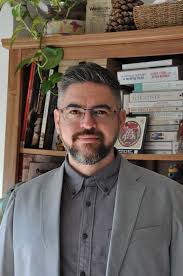 In the present age, students and majority of young people are heavily engaged and reliant on smart devices (smart phones and tablet PCs) as part of daily routines. It is therefore wise to take advantage of this avenue to deliver learning tools right into the hands of students. Advances in digital technologies in the form of portable smart devices and app-based sensor technologies, such as infrared thermal imaging and near infrared spectroscopy devices, have made the development and application of novel tools for teaching and learning purposes in plant physiology readily accessible. The adeptness of students to handheld technology enabled these tools to be easily implemented, with high reception, engagement and interest.
In the present age, students and majority of young people are heavily engaged and reliant on smart devices (smart phones and tablet PCs) as part of daily routines. It is therefore wise to take advantage of this avenue to deliver learning tools right into the hands of students. Advances in digital technologies in the form of portable smart devices and app-based sensor technologies, such as infrared thermal imaging and near infrared spectroscopy devices, have made the development and application of novel tools for teaching and learning purposes in plant physiology readily accessible. The adeptness of students to handheld technology enabled these tools to be easily implemented, with high reception, engagement and interest.
The recipient of the 2019 Plant Science Teaching Prize for Plant Physiology, Associate Professor Sigfredo Fuentes, University of Melbourne for application of new and emerging technologies for digital teaching and learning in plant physiology.
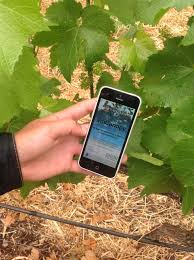 UAVs and Apps
UAVs and Apps
The development of teaching and learning tools based on new and emerging technologies is a critical step to increase engagement of students in complicated physiological processes of plants, such as transpiration rate, stomatal conductance, nutrient levels and photosynthesis rate, among others, that can be assessed in real time. These tools have the potential to be delivered right into the students’ smart phones, providing individualised access and hands-on learning experience. It has been a common practice for students to show these apps to peers and family members, which have increased the engagements of their circles either through direct contact or posting results into social media.
Since 2008, Sigfredo has been actively creating and writing computer codes, programs and computer Applications (Apps) for Plant Science teaching and research. Some of these tools have been adopted commercially and by other national and international tertiary teaching & research institutions in South America (Chile and Argentina), USA, Europe (Spain, France and Italy), China and South Africa. Furthermore, most of the tools have been published in peer reviewed journals and have been used by a number of undergraduate / postgraduate students for their Bachelors, Master and PhD degrees not only in Australia but also around the world. These tools have also helpedtogenerate new ideas on the implementation of computer and sensor applications using the Internet of Things (IoT) in Plant Science and Agriculture and have been used to support lectures and practical from Plant Science, Food Science, Sensory Science, Animal Science, Engineering, Viticulture and Oenology subjects at national and international universities. Specific codes for multivariate statistical analysis have been also developed with respective manuals (teaching publications). These tools have facilitated student learning experience and research performance, resulting in high Student Experience Survey scores (Average of 4.1 from 5 for all subjects).
- Wetting Pattern Analyser (WPA©): 2D and 3D visualization of soil moisture and salinity/nutrient patterns from soil moisture/salinity sensors. Adopted commercially by Sentek Pty. Ltd. (www.sentek.com.au).
- BerryAlive: Computer code written in Matlab® to analyse fluorescence microscopy images of berries to estimate berry cell death and shrivel.
- VitiCanopy: A computer application (App) for tablet PCs and smartphones to assess canopy architecture and leaf area index for horticultural crops using cover photography and computer vision algorithms. https://www.plantransig.com/techniques/viticanopy/
- Spatial Vigour / Spectral Analyser:Analysis of spatial canopy vigour and multispectral analysis using computer vision algorithms at the plant-by-plant scale from UAV or satellite imagery,
- IR-CanopyAnalyser: High throughput automated analysis of infrared thermal images from canopies to obtain canopy conductance indices and crop water stress indices.
- PCA-Cov: Principal component and covariance analysis codes for graphical and numerical outputs written in Matlab® with associated manuals. These tools have helped to improve Student Experience Survey scores from courses associated with this type of analysis.
- Inspector-PAW: Computer App developed for Android OS to automatically acquire accelerometer and GPS data from a smartphone device located in backpacks of trained dogs to record data from identified stimuli such as weeds, pest and diseases detection in orchards. Data can be later on mapped using GIS and modelled using machine learning algorithms. Publication under preparation.
- AppleZize App: Computer App developed to identify diameter of apple fruits and extraction of fruit temperature from digital and infrared images in the field. Information acquired is then plugged in developed algorithms using machine learning techniques to assess final fruit size at harvest and sunburn risk. Publications in preparation.
- LeafDetector: Matlab code developed to extract morpho-colorimetric data from scanned/photographed leaves. Data automatically extracted includes more than 15 parameters, such as diameter, perimeter, fractal analysis of the edges, colour in the CieLAB and RGB codes. Machine learning algorithms can be developed to recognise cultivars automatically from leaf images. Applied already to grapevine cultivars and Chinese medicinal plants.
- Machine learning batch analysis:code developed to test machine learning algorithms using plant physiology data as inputs and targets such as: smoke contamination in leaves and berries; transpiration rate (day and night); plant water status, among others. This code tests around 60 ML algorithms, such as Artificial Neural Networks, Decision trees, Support vector machines, among others.
Some Relevant Publications and Tools Employed
- Xiaoyi Wang, Roberta De Bei, Sigfredo Fuentes, Cassandra Collins: Influence of Canopy Management Practices on Reproductive Performance of Semillon and Shiraz Grapevines in a Hot Climate. American Journal of Enology and Viticulture 04/2019; (Tools: 3).
- J. Tongson, S. Fuentes, M. Carrasco-Benavides, M. Mora: Canopy architecture assessment of cherry trees by cover photography based on variable light extinction coefficient modelled using artificial neural networks. Acta horticulturae 02/2019;, DOI:10.17660/ActaHortic.2019.1235.24. (Tools: 3).
- De Bei, S. Fuentes, M.G. Wirthensohn, D. Cozzolino, S.D. Tyerman: Feasibility study on the use of Near Infrared spectroscopy to measure water status of almond trees. Acta horticulturae 10/2018;, DOI:10.17660/ActaHortic.2018.1219.14. (Tools: 4).
- Xue Jinru, Sigfredo Fuentes, Carlos Poblete-Echeverría, Claudia Gonzalez Viejo, Eden Tongson, Baofeng Su (2019): Automated Chinese medicinal plants classification based on machine learning using leaf morpho-colorimetry, fractal dimension and visible / near infrared spectroscopy. International Journal of Agricultural and Biological Engineering (Accepted); (Tools: 9, 10).
- Xue Jinru, Yeman Fan, Baofeng Su, Sigfredo Fuentes(2018): Assessment of Canopy Vigor Information from Kiwifruit Plants Based on a Digital Surface Model from Unmanned Aerial Vehicle Imagery. International Journal of Agricultural and Biological Engineering;, DOI:10.25165/j.ijabe.20191201.4634. (Tools: 4).
- Zuniga M., Ortega-Farias S., Fuentes S., Riveros-Burgos C., Poblete-Echeverria C. 2018. Effects of three irrigation strategies on gas exchange relationships, plant water status, yield components and water productivity on grafted Carmenere grapevines. Frontiers in Agriculture. 9: 992. (Tools: 5, 6).
- Fuentes S., Hernández-Montes E., Escalona JM., Bota J. Gonzalez Viejo C., Poblete-Echeverría C., Tongson E., Medrano H. 2018. Automated grapevine cultivar classification and water stress assessment based on machine learning using leaf morpho-colorimetry, fractal dimension and near-infrared spectroscopy. Computers and Electronics in Agriculture. 151: 311-318. (Tools: 9, 10).
- Sajitha Biju, Sigfredo Fuentes, Dorin Gupta. The use of infrared thermal imaging as a non-destructive screening tool for identifying drought-tolerant lentil genotypes. Plant Physiology and Biochemistry. 127., DOI:10.1016/j.plaphy.2018.03.005. (Tools: 5, 6).
- Maria Romero, Yuchen Luo, Baofeng Su, Sigfredo Fuentes. Vineyard water status estimation using multispectral imagery from an UAV platform and machine learning algorithms for irrigation scheduling management. Computers and Electronics in Agriculture. 147., DOI:10.1016/j.compag.2018.02.013. (Tools: 4, 10).
- Suyoung Park, Dongryeol Ryu, Sigfredo Fuentes, Hoam Chung, Esther Hernández-Montes, Mark O’Connell: Adaptive Estimation of Crop Water Stress in Nectarine and Peach Orchards Using High-Resolution Imagery from an Unmanned Aerial Vehicle (UAV). Remote Sensing 08/2017; 9(828)., DOI:10.3390/rs9080828. (Tools: 4, 5).
- Baofeng, S., Jinru, X., Chunyu, X., Yulin, F., Yuyang, S., & Fuentes, S.(2016). Digital surface model applied to unmanned aerial vehicle based photogrammetry to assess potential biotic or abiotic effects on grapevine canopies. International Journal of Agricultural and Biological Engineering, 9(6), 119. (Tools: 4).
- Mora, M., Avila, F., Carrasco-Benavides, M., Maldonado, G., Olguín-Cáceres, J., & Fuentes, S.(2016). Automated computation of leaf area index from fruit trees using improved image processing algorithms applied to canopy cover digital photograpies. Computers and Electronics in Agriculture, 123, 195-202. (Tools: 3).
- De Bei, R., Fuentes, S., Gilliham, M., Tyerman, S., Edwards, E., Bianchini, N., . . . Collins, C. (2016). VitiCanopy: A free computer App to estimate canopy vigor and porosity for grapevine. Sensors, 16(4), 585. (Tools: 3).
- Carrasco-Benavides, M., Mora, M., Maldonado, G., Olguín-Cáceres, J., von Bennewitz, E., Ortega-Farías, S., John Gajardo and Fuentes, S.(2016). Assessment of an automated digital method to estimate leaf area index (LAI) in cherry trees. New Zealand Journal of Crop and Horticultural Science, 44(4), 247-261. (Tools: 3).
- Park, S., Nolan, A., Ryu, D., Fuentes, S., Hernandez, E., Chung, H., & O’Connell, M. (2015) Estimation of crop water stress in a nectarine orchard using high-resolution imagery from unmanned aerial vehicle (UAV). Paper presented at the MODSIM2015, 21st International Congress on Modelling and Simulation. (Tools: 5).
- Nolan, A., Park, S., Fuentes, S., Ryu, D., & Chung, H. (2015). Automated detection and segmentation of vine rows using high resolution UAS imagery in a commercial vineyard.Paper presented at the MODSIM2015, 21st International Congress on Modelling and Simulation. (Tools: 5).
- Poblete-Echeverría, C., Fuentes, S., Ortega-Farias, S., Gonzalez-Talice, J., & Yuri, J. A. (2015). Digital cover photography for estimating leaf area index (LAI) in apple trees using a variable light extinction coefficient. Sensors, 15(2), 2860-2872. (Tools 3).
- Fuentes, S., Poblete‐Echeverría, C., Ortega‐Farias, S., Tyerman, S., & De Bei, R. (2014). Automated estimation of leaf area index from grapevine canopies using cover photography, video and computational analysis methods. Australian Journal of Grape and Wine Research, 20(3), 465-473. (Tools: 3).
- Bonada, M., Sadras, V., Moran, M., & Fuentes, S.(2013). Elevated temperature and water stress accelerate mesocarp cell death and shrivelling, and decouple sensory traits in Shiraz berries. Irrigation Science, 31(6), 1317-1331. (Tools: 2).
- Fuentes, S., Mahadevan, M., Bonada, M., Skewes, M., & Cox, J. (2013). Night-time sap flow is parabolically linked to midday water potential for field-grown almond trees. Irrigation Science, 31(6), 1265-1276. (Tools: 2).
- Bonada, M., Sadras, V. O., & Fuentes, S. (2013). Effect of elevated temperature on the onset and rate of mesocarp cell death in berries of Shiraz and Chardonnay and its relationship with berry shrivel. Australian Journal of Grape and Wine Research, 19(1), 87-94. (Tools: 2).
- Conn, S. J., Hocking, B., Dayod, M., Xu, B., Athman, A., Henderson, S., . . . Fuentes, S.(2013). Protocol: optimising hydroponic growth systems for nutritional and physiological analysis of Arabidopsis thaliana and other plants. Plant Methods, 9(1), 4. (Tools: 9).
- Fuentes, S., De Bei, R., Pech, J., & Tyerman, S. (2012). Computational water stress indices obtained from thermal image analysis of grapevine canopies. Irrigation Science, 30(6), 523-536. (Tools: 5).
- Fuentes, S., Sullivan, W., Tilbrook, J., & Tyerman, S. (2010). A novel analysis of grapevine berry tissue demonstrates a variety‐dependent correlation between tissue vitality and berry shrivel. Australian Journal of Grape and Wine Research, 16(2), 327-336. (Tools: 2).


Lastly, register for our meeting. You have until Wednesday July 31st to register and submit abstracts for talks and posters. There will not be a later date for posters at this stage. It’s T-minus 10 days. Let the countdown begin…….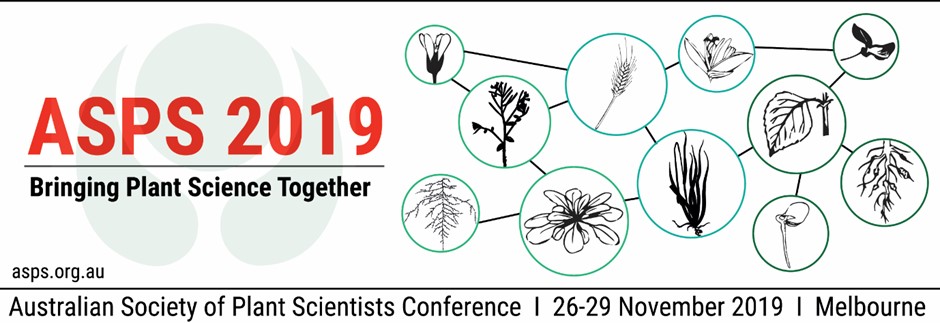

Phytogen – June 2019
16 June 2019
Welcome all to Phytogen for June 2019. I know it gets busy this time of year. Hopefully you can manage a couple of brain breaks and send some images and enjoy reports from students and researchers who attended ComBio 2018 in Sydney 2018. Keep reading…..
In this issue we would like to collect images from you for banners to be displayed at the upcoming Translational Photosynthesis Conference 2019, Brisbane June 30 – July 3. We will also use them at our November meeting too. The images will be inserted into this mask:

We can only accept images until Friday 21st June. Please email images to Tam Salter and ensure they are .PNG , .jpg, .TIFF, or .pdf, with greater than 300 dpi, email: william.salter@sydney.edu.au
If the images have people, they will have to sign a permission form: ASPSphotopermission Please print the permission form and have them sign then send along with your entry to Tam, we look forward to receiving your images.
Here is a reminder to register for our meeting this year:
 Early registration will apply until 30 June 2019 register
Early registration will apply until 30 June 2019 register
Four ASPS Award Lectures:
- Peter Goldacre Award Presentation & Lecture: Simon Williams, Australian National University
- Jan Anderson Award Presentation & Lecture: The Australian Society of Plant Scientists congratulates Monika Murcha, University of Western Australia (https://research-repository.uwa.edu.au/en/persons/monika-murcha) as recipient of the prestigious 2019 ASPS Jan Anderson award. This award acknowledges talented female plant science researchers. Dr Murcha will be presenting the Anderson lecture at ASPS 2019 (https://www.asps.org.au/combio/asps-2019).
- JG Wood Award Presentation & Lecture: Ros Gleadow, Monash University
- ASPS Teaching Award Presentation & Lecture: Sigfredo Fuentes, University of Melbourne
International Speakers include:
- Prof George Bassel, University of Birmingham
- Prof Dan Szymanski, Purdue University
ComBio2018 reports
Aruni Alahakoon, PhD candidate, Faculty of Veterinary and Agricultural Sciences, University of Melbourne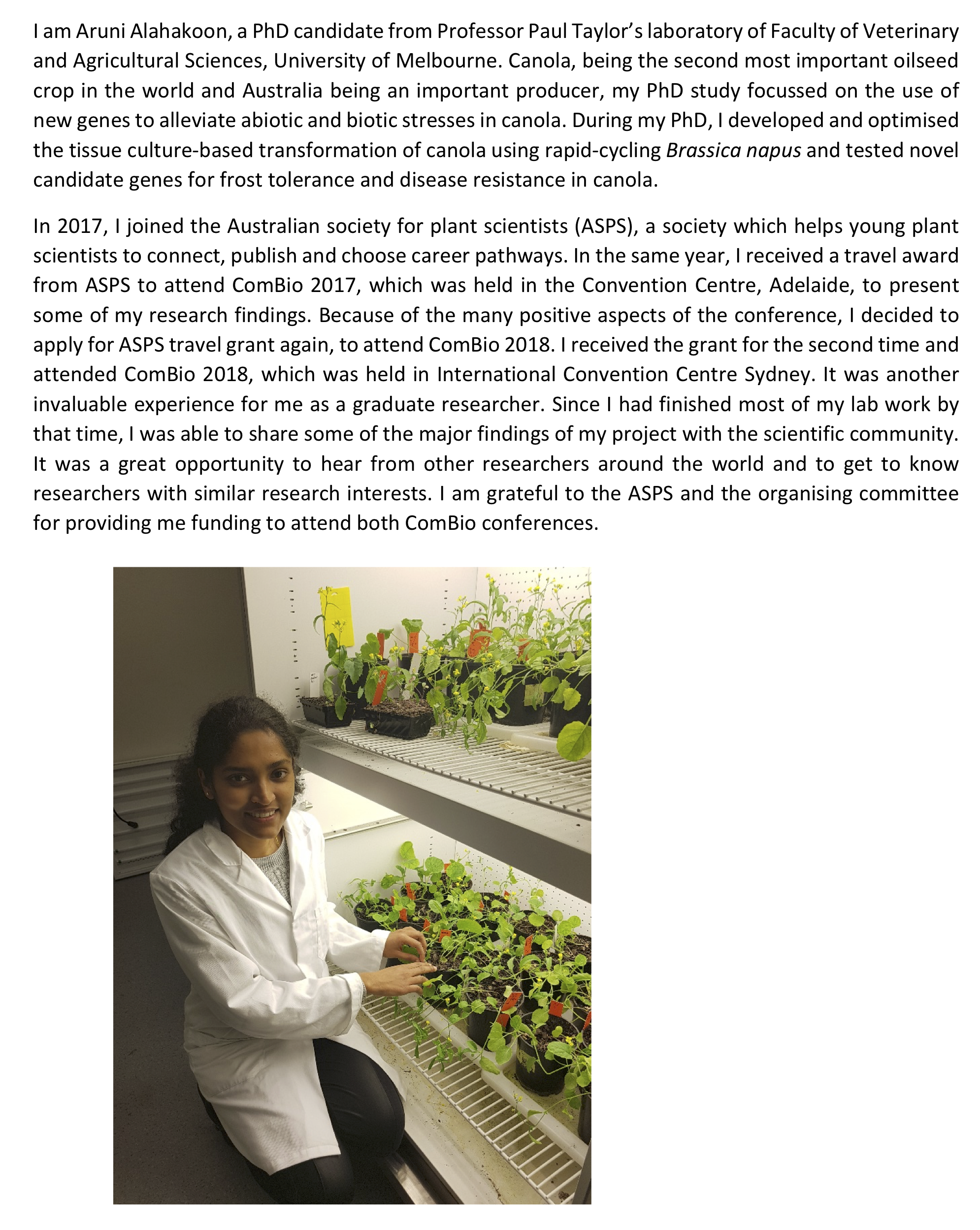
Nicholas Booth, Honours student, Flinders University, College of Science and Engineering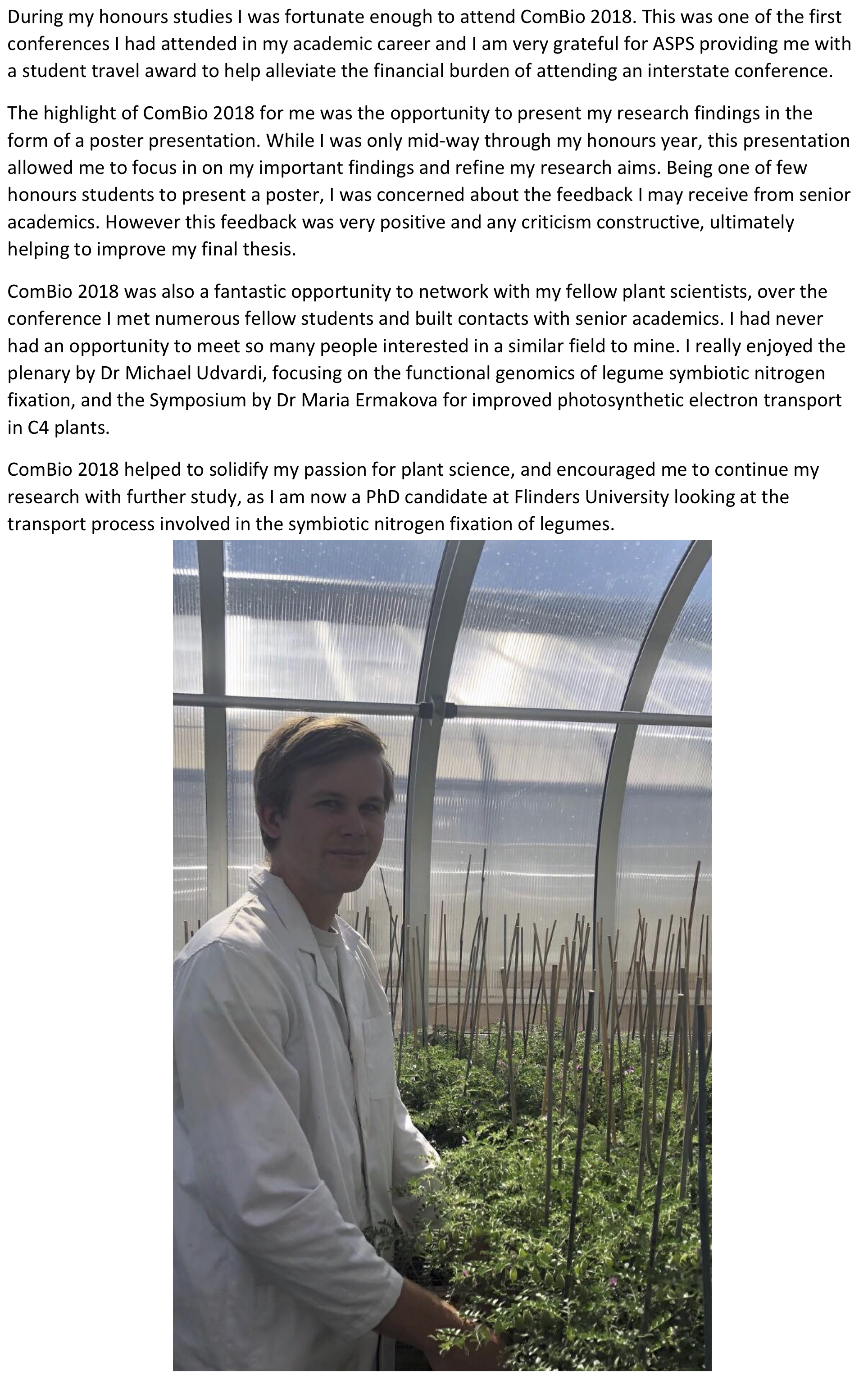
Duc Quan Nguyen, PhD candidate, School of Environmental and Life Science, University of Newcastle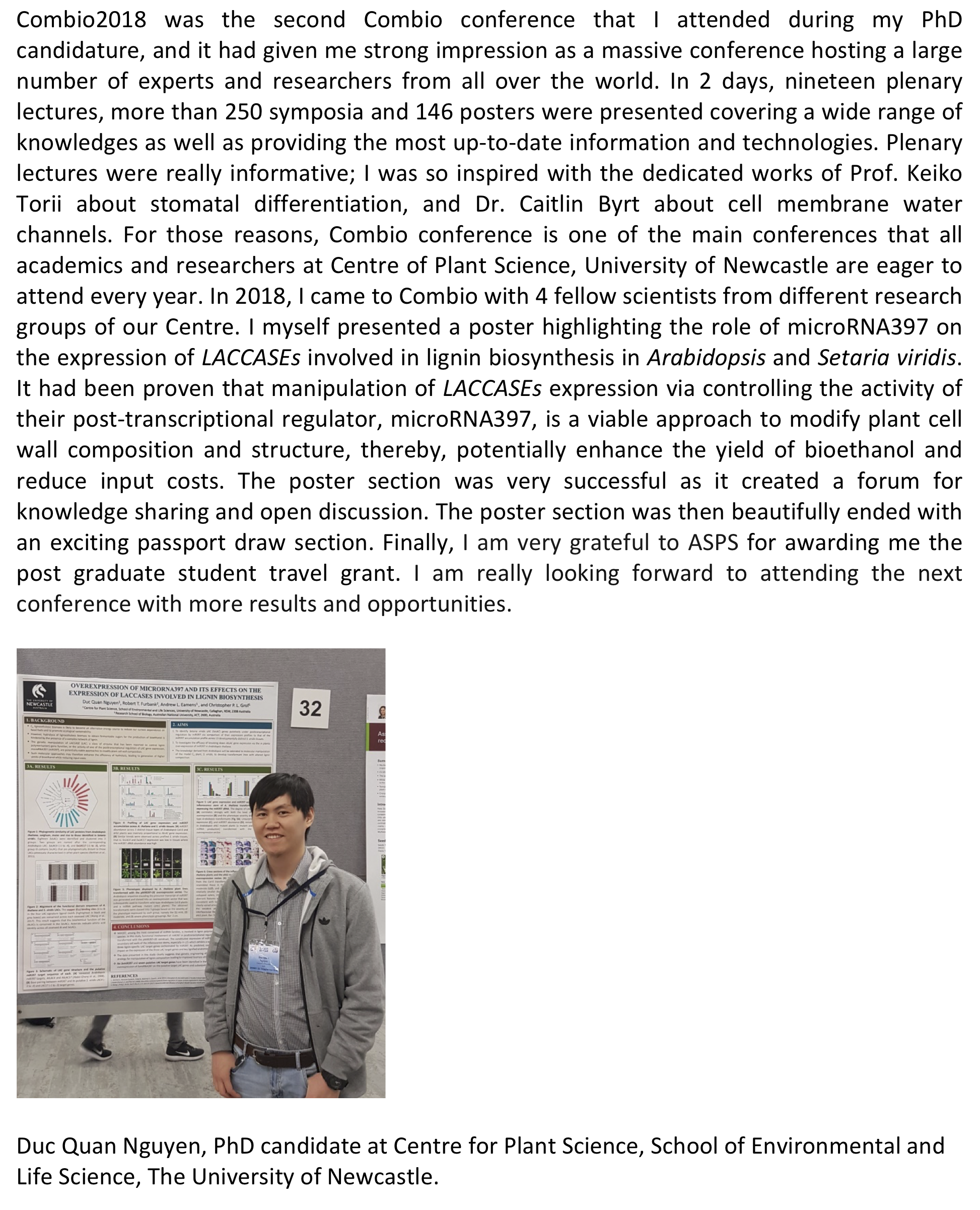
Sayed Mohammad Mohsin, PhD candidate School of Agricultural Sciences, Ehime and Kagawa Universities, Japan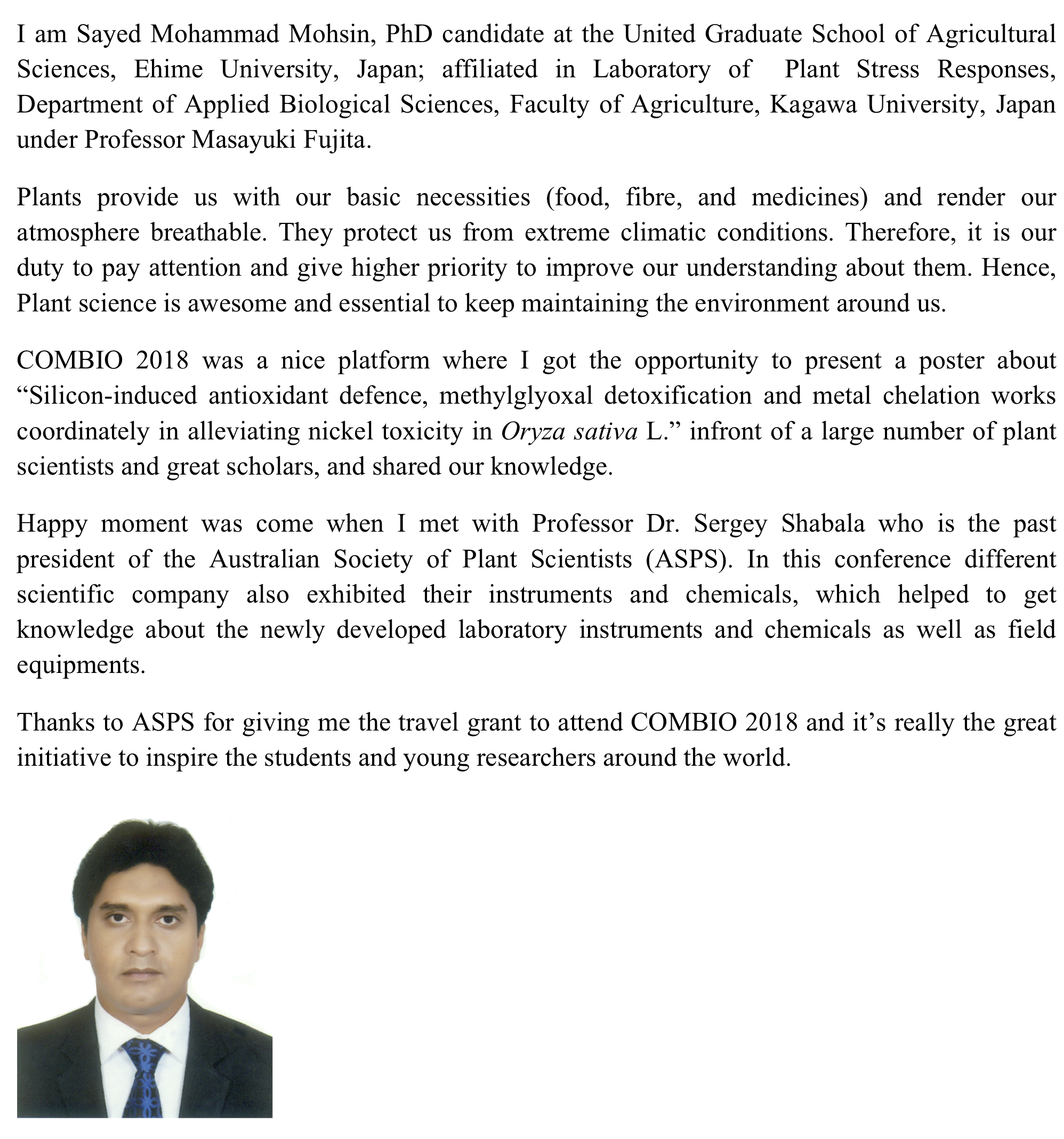
Pei Qin Ng, PhD candidate, School of Biological Sciences, University of Adelaide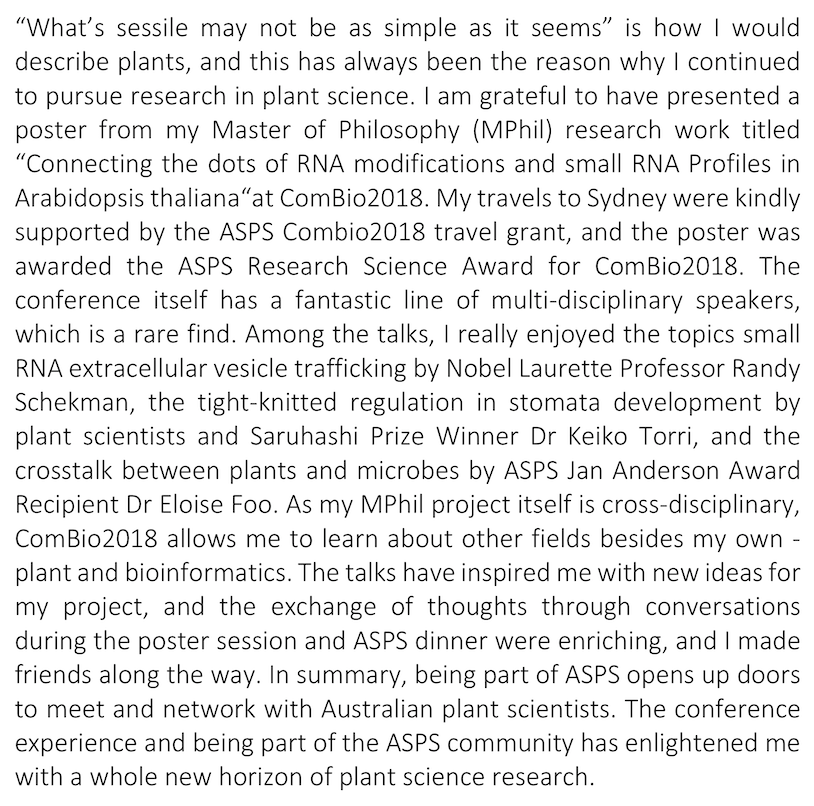

Yu Zhou, PhD Candidate, Research School of Biology, ANU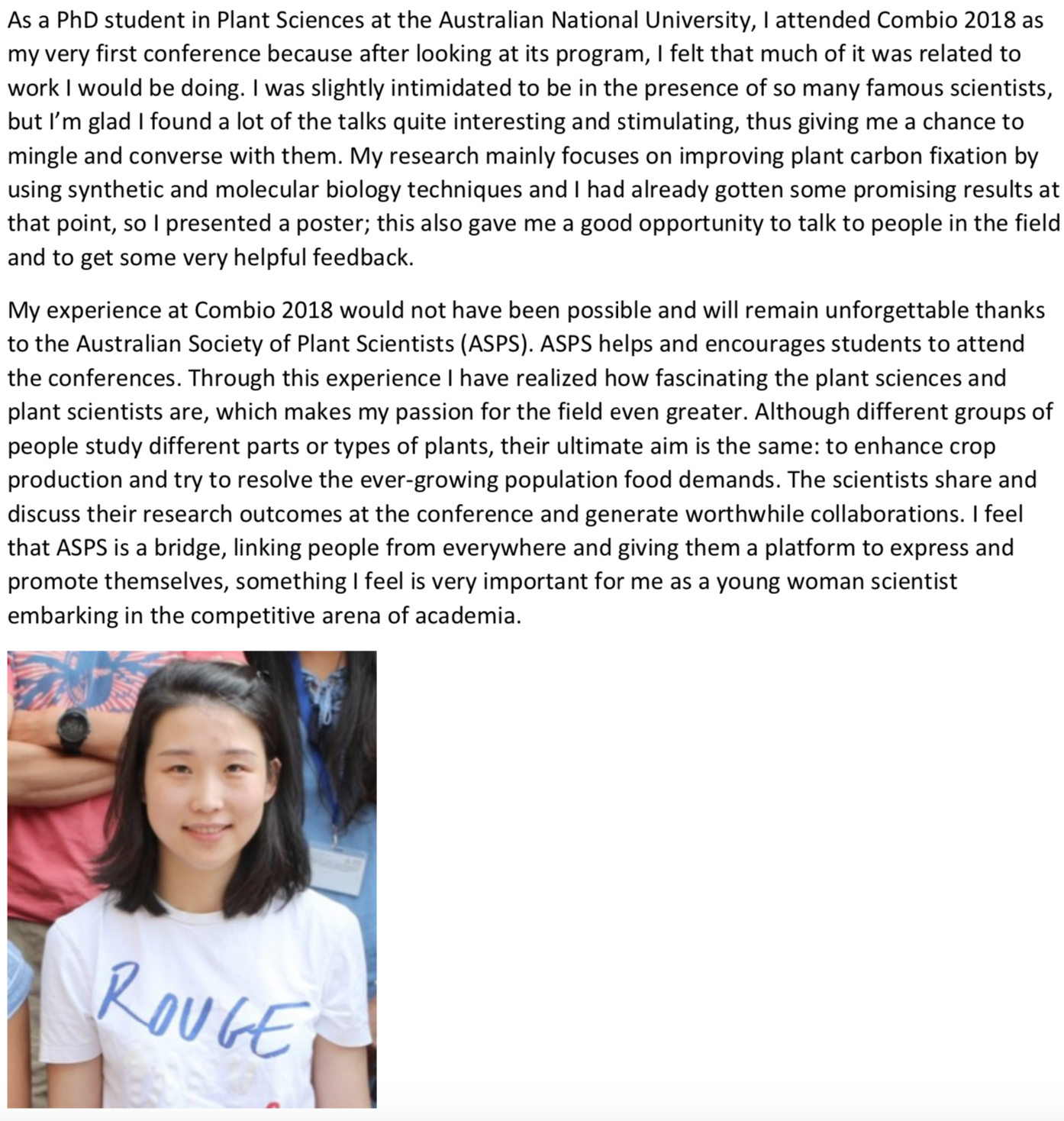
Christopher Waterman, PhD Candidate, College of Science and Engineering, Flinders University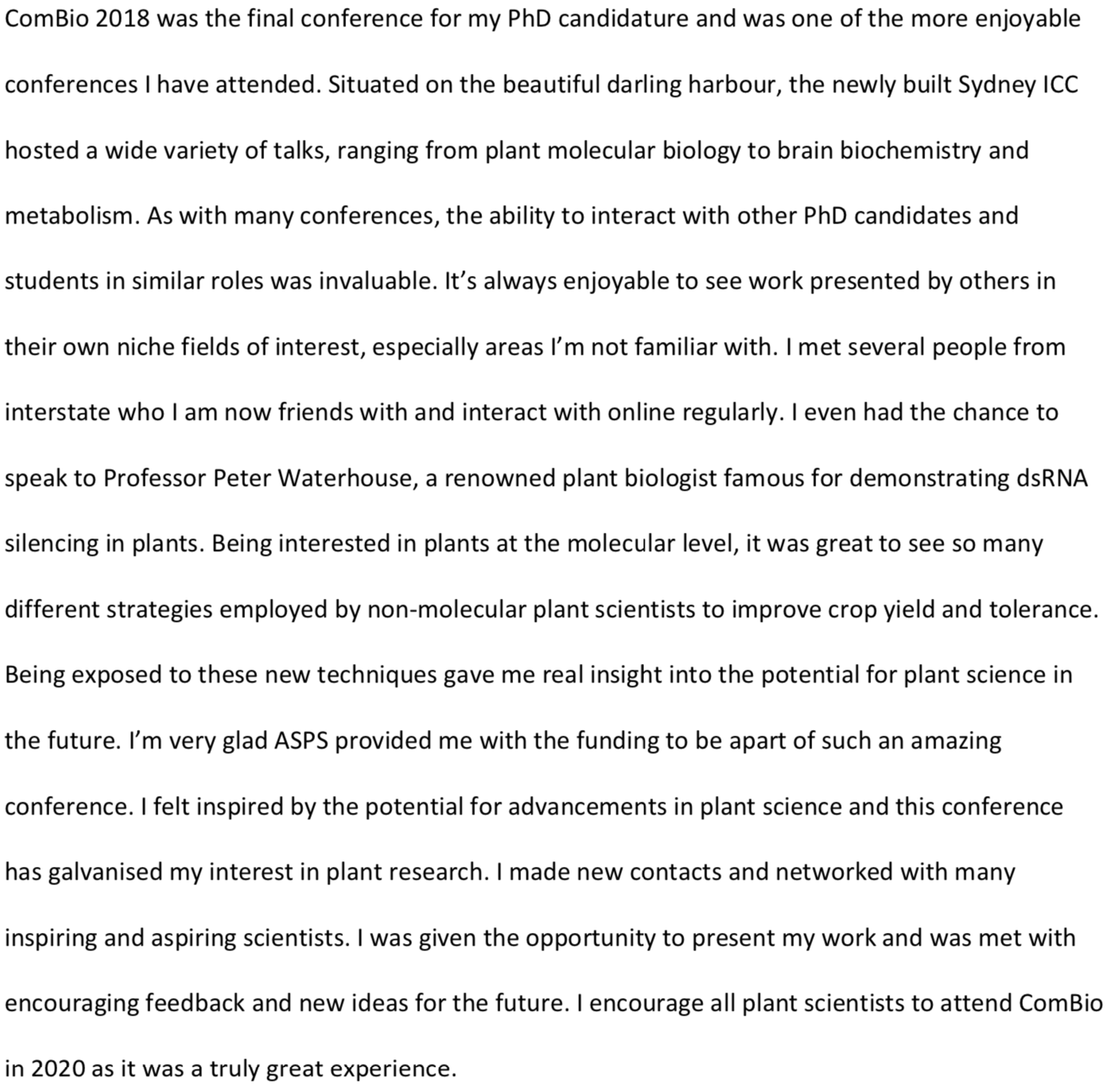
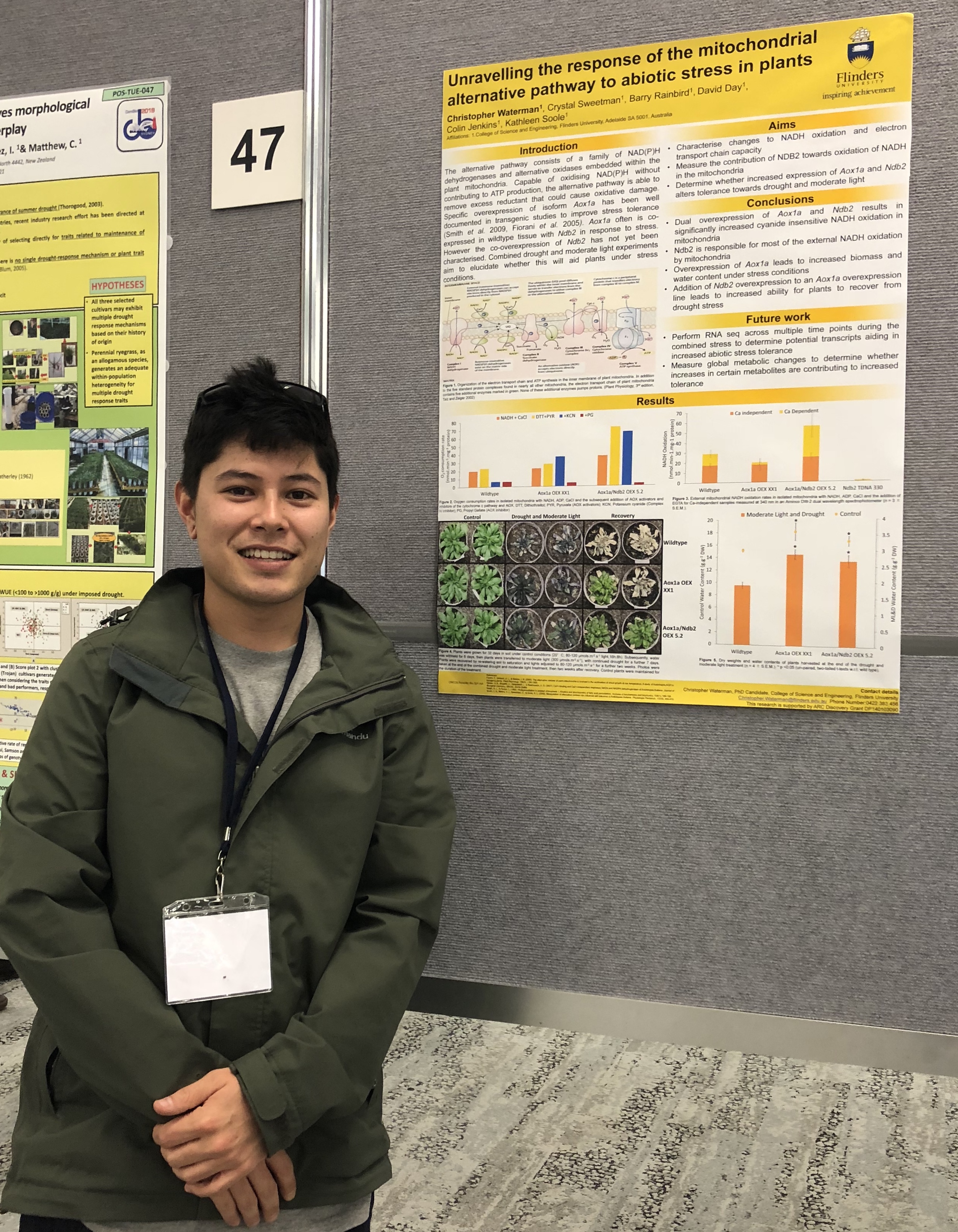
Eric Brenya, PhD Candidate, Hawkesbury Institute for the Environment, Western Sydney University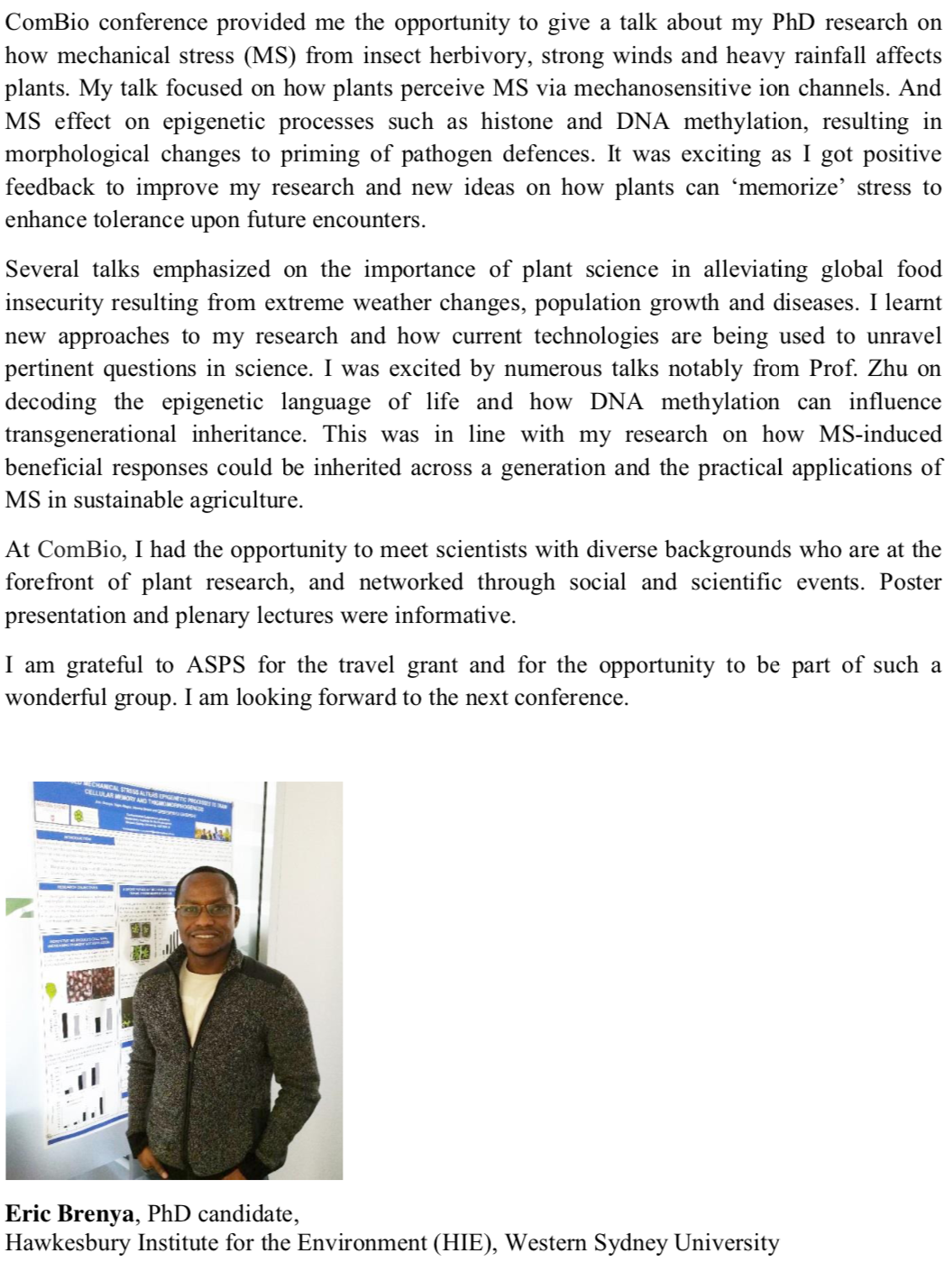
Sally Buck, PhD Candidate, Research School of Biology, ANU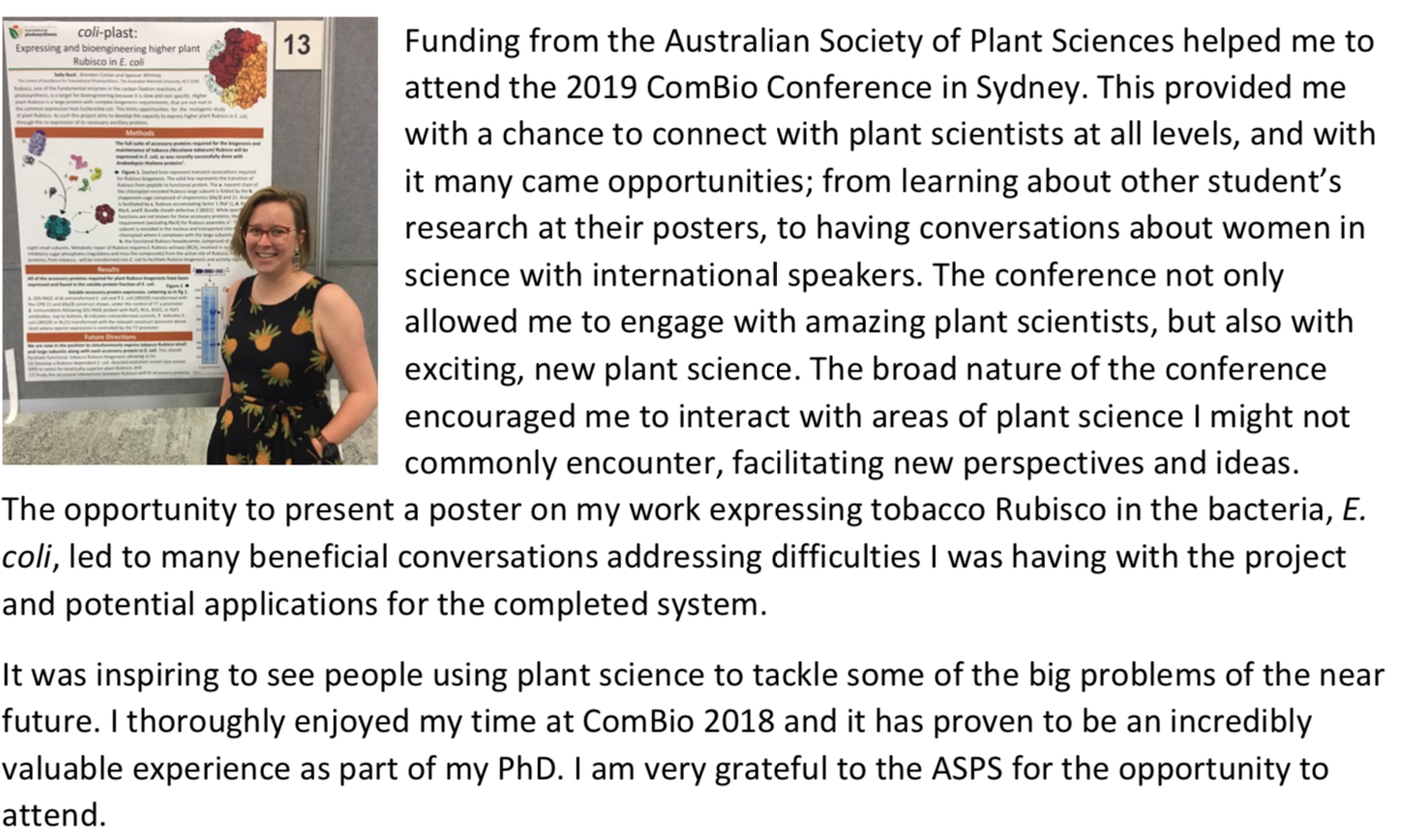
Dr Nicole Pontarin, Université de Picardie Jules Verne, BIologie des Plantes et Innovation (BIOPI), Amiens, France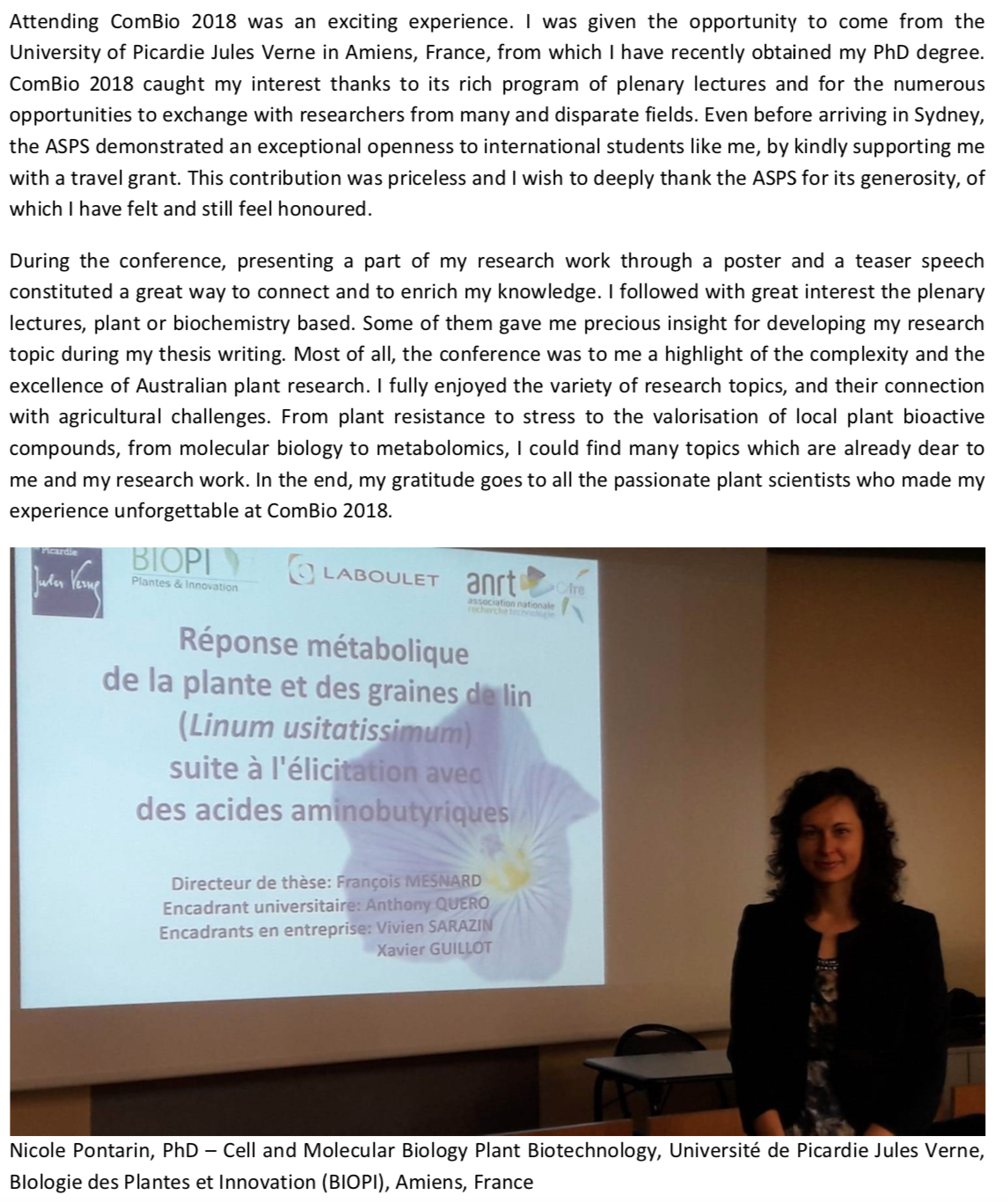
Dr Yagiz Alagoz, Hawkesbury Institute for the Environment, Western Sydney University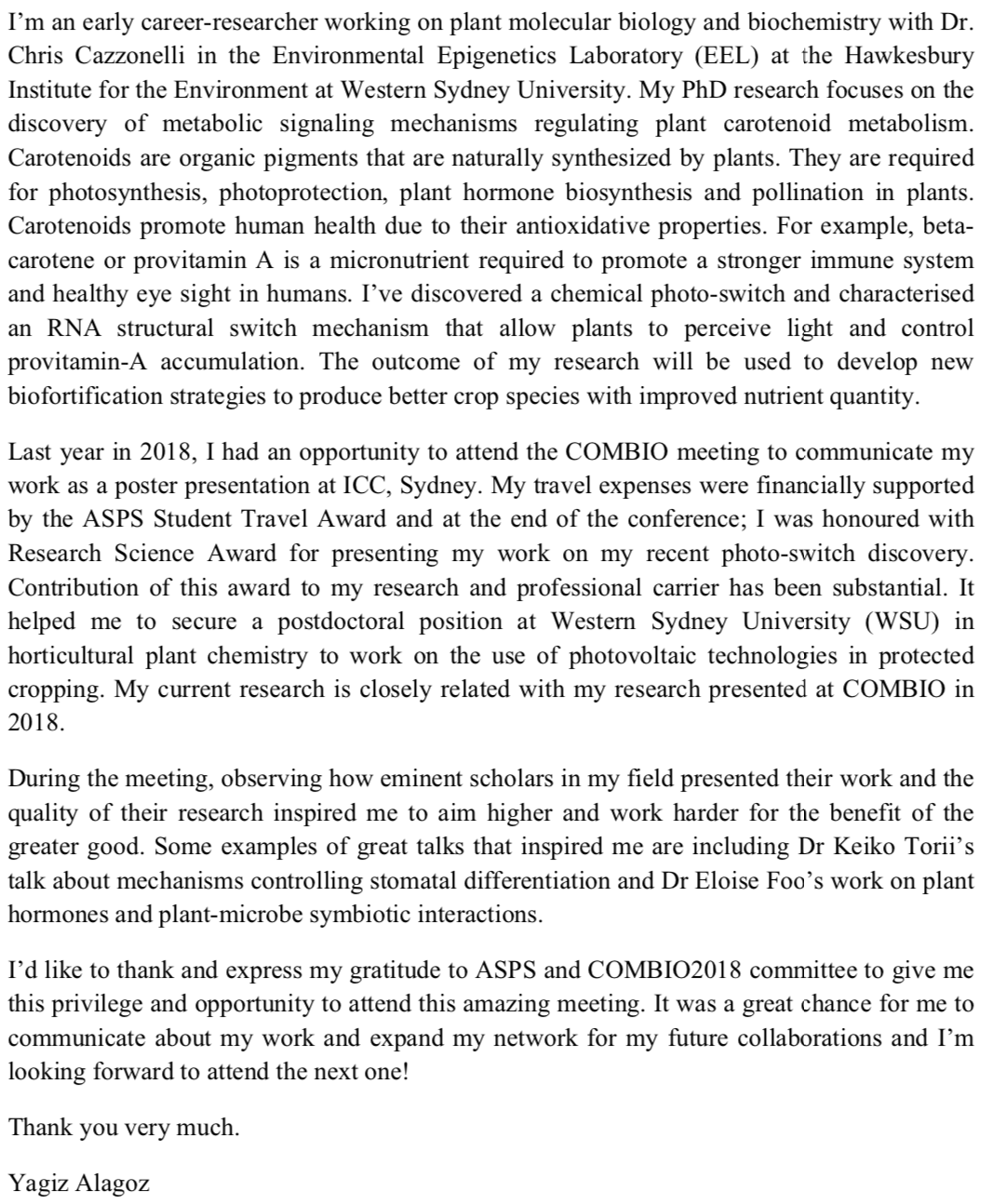
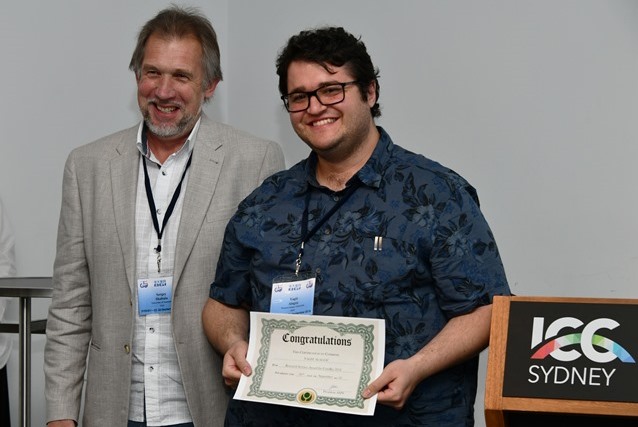
Johanna Wong, PhD candidate, The Hawkesbury Institute for the Environment, Western Sydney University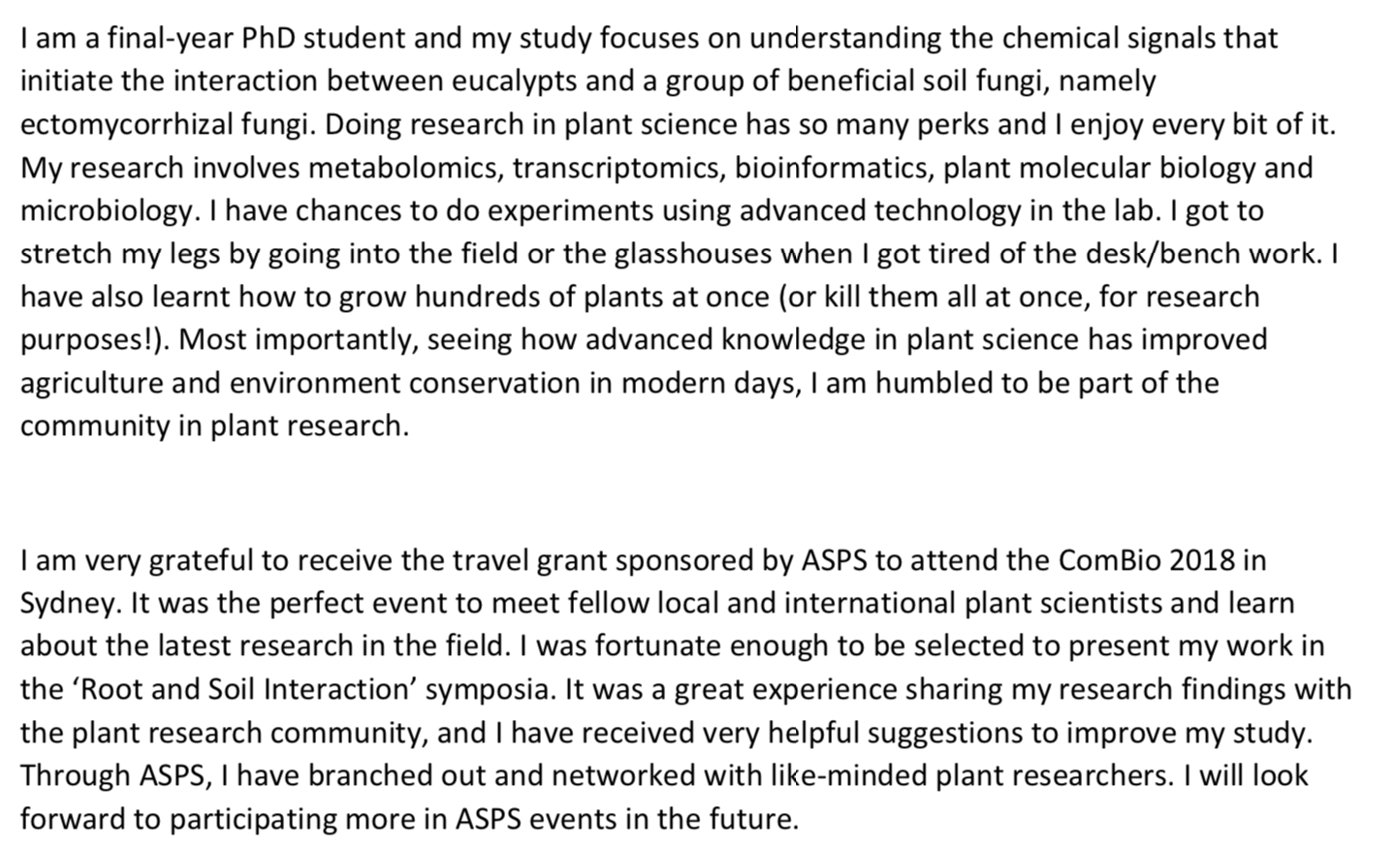
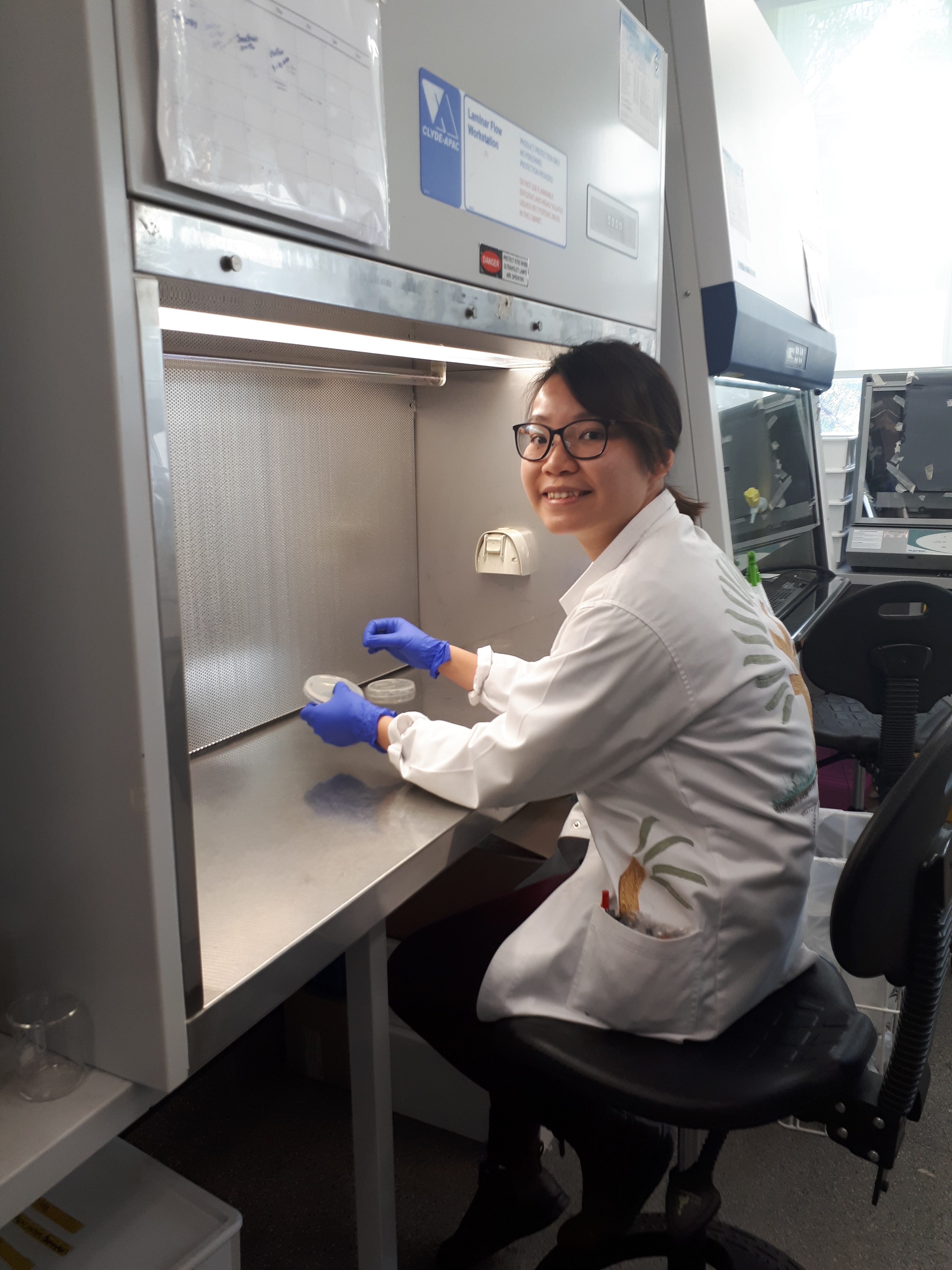
Phytogen – May 2019
12 May 2019
Welcome to May Phytogen, hopefully you have had some rain and it is now cooler.
- International Fascination of Plants Day, Saturday 18th May. After you vote, take some pics of plants and add to our ASPS site on twitter by entering @asps_ozplants into the search twitter window. Tag #plantday and @PlantDay18May. There is still time to register an event, and we have requested a code for Australia and will add events when posted to @asps_ozplants. Events can be throughout all of May. If you would like some tips to help with twitter read this article by Tam Salter: Guide to ASPS and twitter
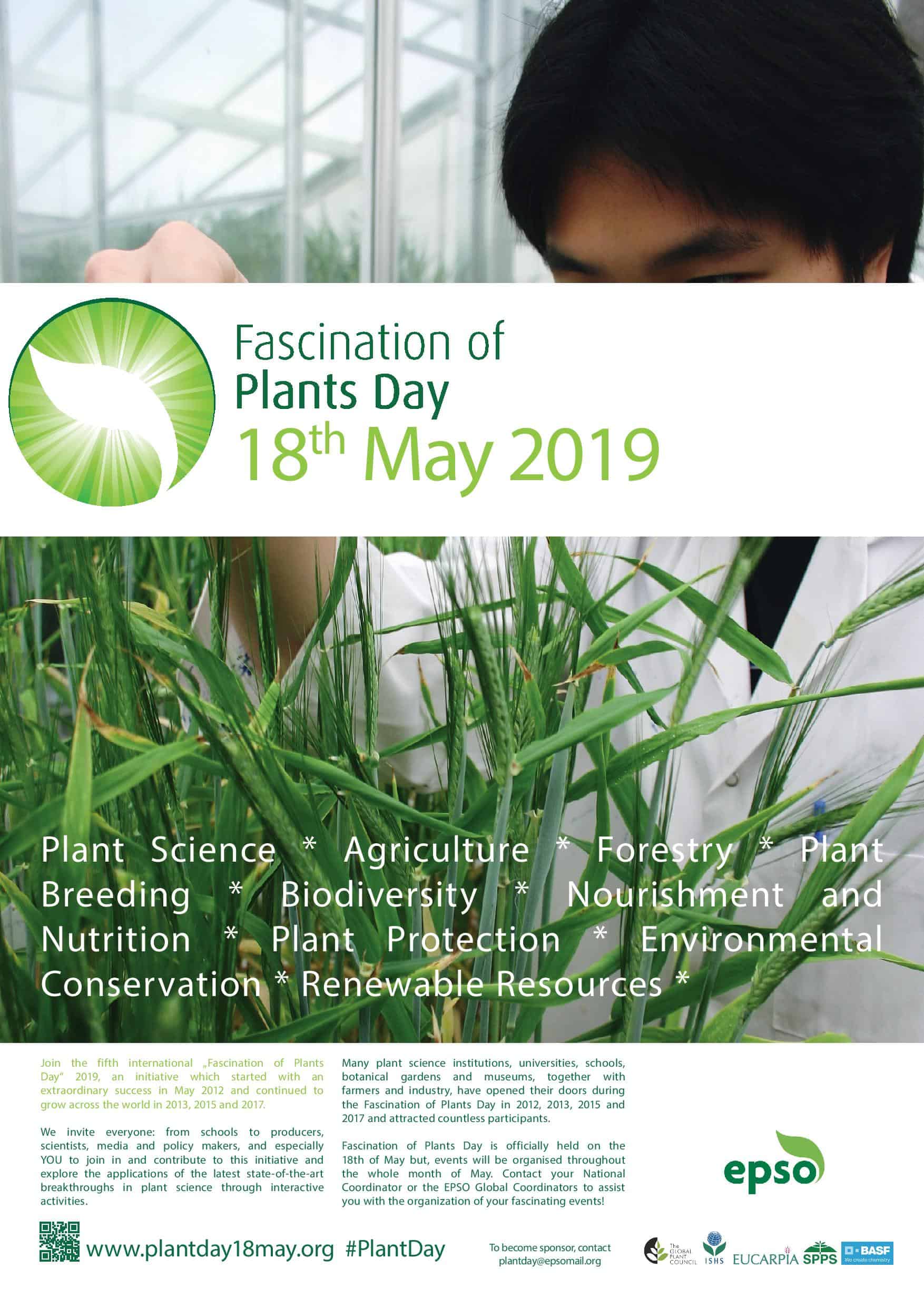
2. Look forward to seeing you at ASPS 2019 Tuesday 26th-Friday 29th November 2019. Remember, applications for student travel awards by Friday June 14 and early registration until June 28. Have a go at twitter to #ASPS2019 to let us know after you have registered.
Four ASPS Award Lectures:
- Peter Goldacre Award Presentation & Lecture: Simon Williams, Australian National University
- Jan Anderson Award Presentation & Lecture: to be announced
- JG Wood Award Presentation & Lecture: to be announced
- ASPS Teaching Award Presentation & Lecture: to be announced
International Speakers include:
- Prof George Bassel, University of Birmingham
- Prof Dan Szymanski, Purdue University
Latrobe University have also setup a nice website with map.
3. It is reassuring that science, STEM (see Science and Technology Australia) and our environment are well represented this upcoming Federal election. There are statements from The Australian Academy of Science, plus their EMCR forum. @ScienceAU is excellent for following the all the action.
4. ComBio2020, for you to be able to plan ahead for 2020. www.combio.org.au/combio2020
Phytogen-April 2019
24 April 2019
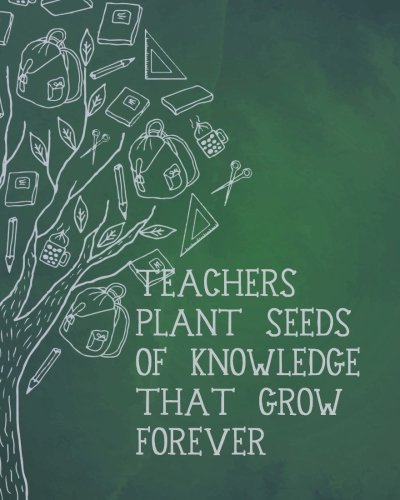
Here is a report from 2018 ASPS teaching award recipient – Beth Loveys
During my PhD and then subsequent post-doctoral research positions I had not really considered the possibility of becoming a teaching only academic, mainly because I was not aware such positions existed! I always assumed I would continue doing research with some teaching when necessary. Three children and several moves chasing short term research contracts made me think more broadly about what a future career in science might look like for me. I had always enjoyed teaching, even as demonstrator during my PhD, and coming across an advert for a teaching only academic at the University of Adelaide got me thinking.
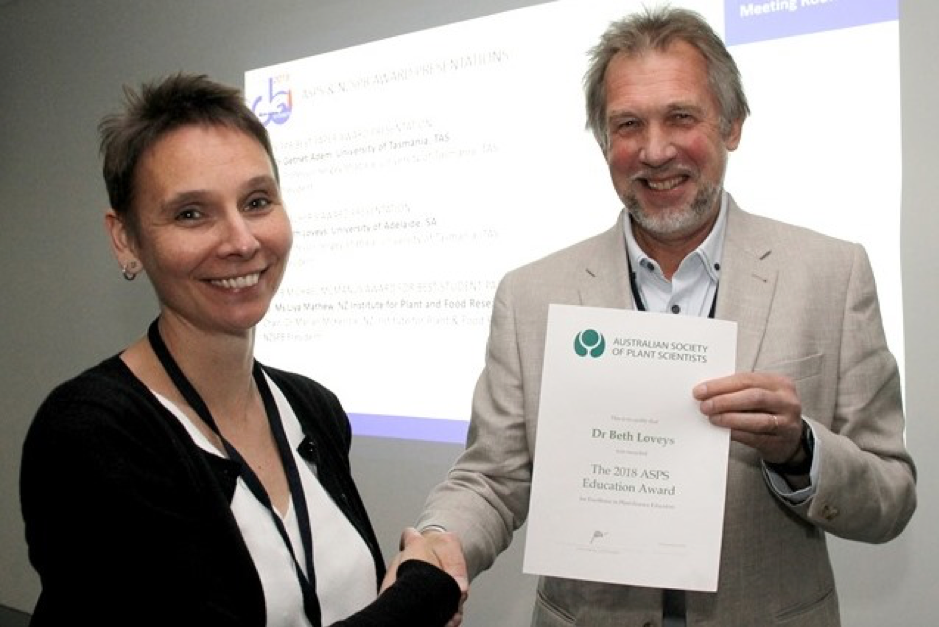
Beth receiving her award from ASPS president Professor Sergey Shabala
After being appointed in the teaching only position I quickly learnt that being an effective teacher in large classes was not an easy task. I quickly realised the best resources available to me where not only my colleagues but also the students themselves. There is no better way to trouble-shoot problematic courses or topics than to ask the students where they are getting stuck. Over the first 5 years of my teaching only position I immersed myself in teaching pedagogy literature to begin understanding the best ways to support students in their learning. This knowledge allowed me to develop learning resources to help students grasp complex topics in plant science and biochemistry. The scientist in me wanted data to support the decisions I was making about teaching methodologies and resources, this meant I had to learn how to deal with qualitative data and the moving target of different cohorts of students each year. These data have allowed me to reflect in an objective way about what works and what doesn’t work and where the biggest gains in student comprehension can be made. Over the last two years I have become increasingly interested in working with students as partners in developing curriculum.
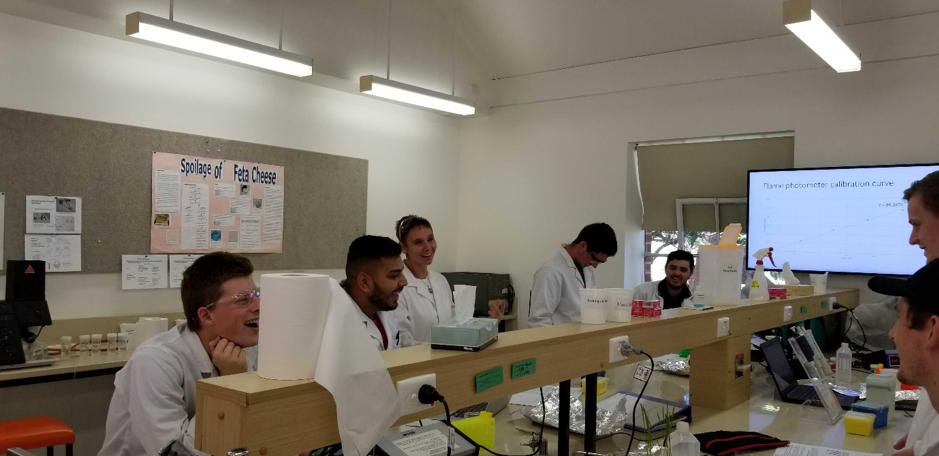
Beth working the lab with her Foundations in Plant Science students
It was a real honour to be awarded the ASPS Teaching Award in 2018, recognition from science peers is both humbling and pleasing. Since receiving the award I undertook a project to build video resources for supporting a mixed cohort of undergraduate, postgraduate, domestic and international students in mastering practical winemaking and laboratory skills. Senior students demonstrated, scripted and recorded voice over narration for all videos. Two of the senior students involved with the project were international students so were able to translate all scripts into Cantonese as additional support for the growing cohort from China. The input of the senior students was invaluable to create videos that were appropriate for the incoming cohort. An example of one of the videos can be seen here:
As the student population becomes increasingly diverse, culturally and demographically, having resources that support independent learning outside of prescribed class time is essential. For these resources to be of maximum benefit they must be well designed with embedded feedback so that students are able to gain confidence outside of class and thus be better prepared for their time with the teacher in class.
There is a website with education conferences, Aussie Educator that covers all ages from junior to academia, STEM, national and international. On the site are two international education conferences coming up in Adelaide this year. The conferences cover all discipline areas in tertiary education. One focuses on the emerging pedagogy of Students as Partners and the other focuses on the teaching-research nexus. Registration is discounted if you attend both conferences! Click on the pictures below to expand.
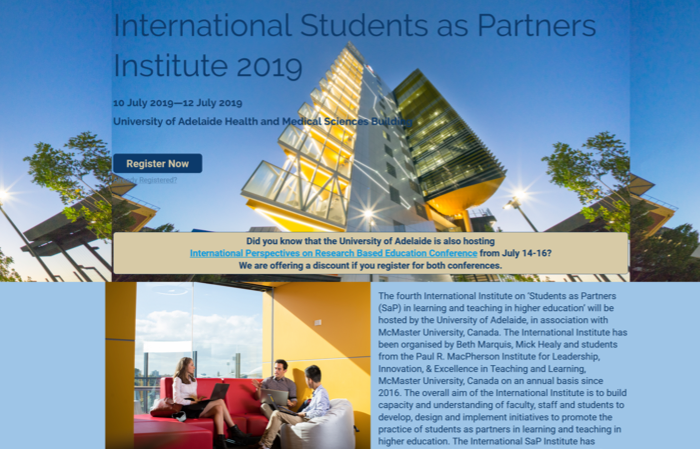 |
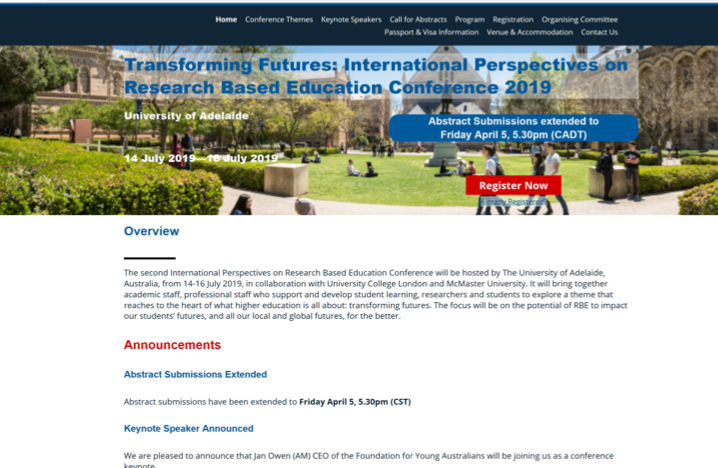 |
To finish off for this month:
Hope you have registered for our ASPS meeting in Melbourne this year and students please apply for travel support by Friday June 14.
Next month: Reports from student travel awards 2018 and it would be nice to promote a Plants event near you for International Fascination of Plants Day on Sunday May 19. There isn’t an event registered for Australia yet…… see how you go.
Phytogen – March 2019
24 March 2019
This month we are promoting books and conferences. CABI, The Centre for Agriculture and Bioscience International, is a not-for-profit inter-governmental development and information organisation focusing primarily on agricultural and environmental issues in a developing world. There is a new book co-edited by Sergey Shabala and they have set up a discount for ASPS members on all CABI books. The code to use is CCAB20, which is valid for 20% off individual orders through the CABI Bookshop. Below is a jacket for Halophytes and Climate Change – all of CABI’s work and books look great !
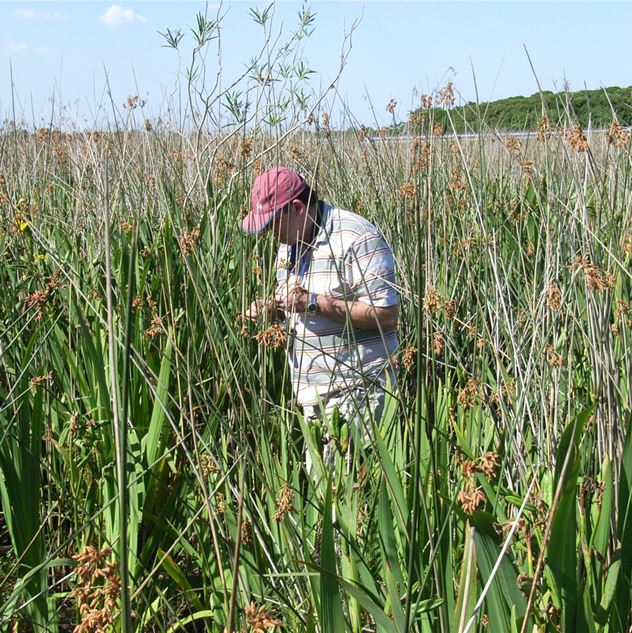
|
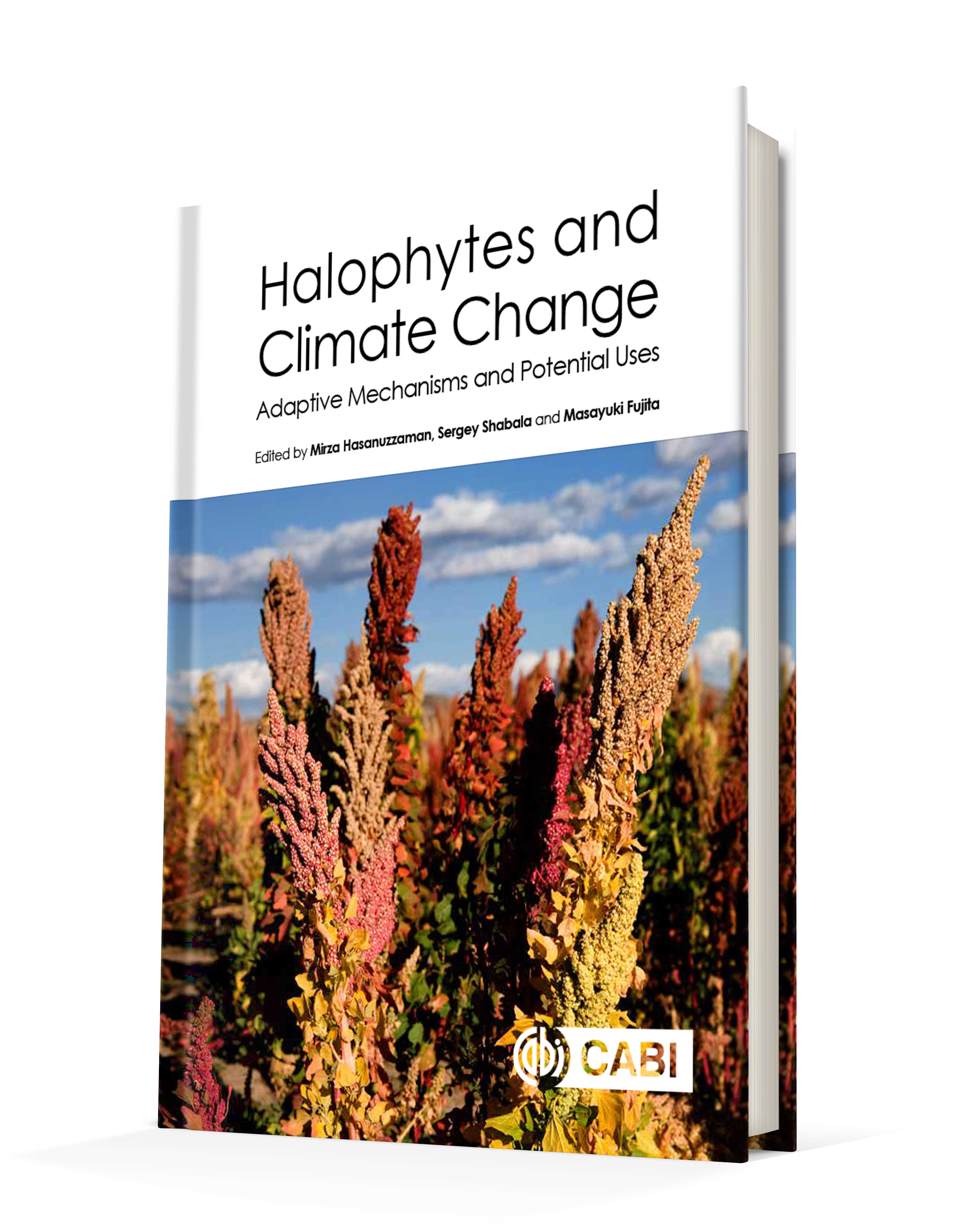 |
Hope to see you at ……..
The ASPS conference will cover diverse aspects of plant biology including: Student Sessions, Breeding for Human Nutrition, Reproductive and Seed Biology, Plant Nutrition, Genome Regulation: Tissues and Cells, Phenotyping Technologies, Medicinal Agriculture, Plant Development, Communication and Education, Abiotic Stress and Biotic Interactions. On the Friday 29th is a Grains Satellite Meeting.
Registration and Abstract submission is now open !
See website: https://www.asps.org.au/combio/asps-2019 for links to registration, abstract submission and student travel grants.
keep up with ASPS and conference information on twitter : ASPS (@asps_ozplants)
another great conference not to be missed…..
This conference brings together the key elements for a future food revolution.
Registration and Abstracts : Monday 1st April 2019, just over a week to go !
see website for information, http://photosynthesis.org.au/innovag/
keep up with the centre on twitter: ARC CoETP (@leaf2field)
Truly inspiring words from Dr Eloise Foo – Inaugural Jan Anderson Award 2018
14 February 2019
While you are preparing your applications for the Jan Anderson award 2019, below are some words from Dr Eloise Foo, awarded inaugural Jan Anderson Award 2018. She writes about achieving balance in life and there are parallels to her research area of how plants and microbes navigate their dual existence, to read more: Strigolactones in Plant Interactions with Beneficial and Detrimental Organisms: The Yin and Yang, Juan A. López-Ráez, Ken Shirasu, Eloise Foo, Trends in Plant Science, DOI:https://doi.org/10.1016/j.tplants.2017.03.011
Applications for Jan Anderson Award 2019 close Thursday 28th February. Follow the link for more details.
Dr Eloise Foo, ARC Future Fellow, School of Natural Sciences, University of Tasmania
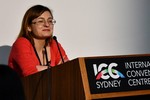 My research examines how plants form intimate relationships with soil microbes that give them access to essential nutrients. These relationships are ancient, widespread and often essential for plants to thrive in challenging conditions. I am fascinated with how plants and microbes communicate through chemical signals to negotiate these interactions. I absolutely love working in research, the intellectual freedom to observe, pose questions and then seek to answer them is such a creative and satisfying endeavour. I was so honoured to receive the inaugural Jan Anderson Award in 2018. Delivering the lecture at Combio 2018 to such a warm and supportive community was a true highlight and enabled me to reflect on the fantastic mentors and colleagues I have had. I feel real change is afoot to enable people to balance a research career with all the other great things in life (family, leisure time, community). This is not just to support women to navigate the challenging but rewarding path to a research career but also opens up a different way for everyone to lead successful and balanced lives.
My research examines how plants form intimate relationships with soil microbes that give them access to essential nutrients. These relationships are ancient, widespread and often essential for plants to thrive in challenging conditions. I am fascinated with how plants and microbes communicate through chemical signals to negotiate these interactions. I absolutely love working in research, the intellectual freedom to observe, pose questions and then seek to answer them is such a creative and satisfying endeavour. I was so honoured to receive the inaugural Jan Anderson Award in 2018. Delivering the lecture at Combio 2018 to such a warm and supportive community was a true highlight and enabled me to reflect on the fantastic mentors and colleagues I have had. I feel real change is afoot to enable people to balance a research career with all the other great things in life (family, leisure time, community). This is not just to support women to navigate the challenging but rewarding path to a research career but also opens up a different way for everyone to lead successful and balanced lives.
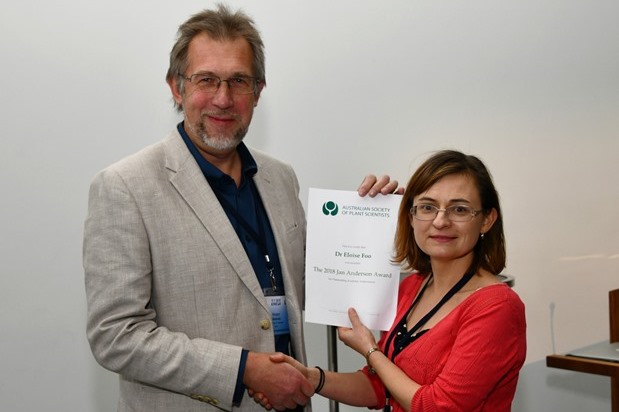 Dr Eloise Foo and Professor Sergey Shabala
Dr Eloise Foo and Professor Sergey Shabala
Eloise.foo@utas.edu.au, http://www.utas.edu.au/profiles/staff/plant-science/eloise-foo
Recent Posts
Tags
Archives
- June 2025
- May 2025
- April 2025
- March 2025
- February 2025
- January 2025
- December 2024
- November 2024
- October 2024
- September 2024
- August 2024
- July 2024
- June 2024
- May 2024
- April 2024
- February 2024
- January 2024
- November 2023
- October 2023
- September 2023
- August 2023
- July 2023
- June 2023
- May 2023
- April 2023
- March 2023
- February 2023
- December 2022
- November 2022
- October 2022
- September 2022
- August 2022
- July 2022
- June 2022
- May 2022
- April 2022
- March 2022
- February 2022
- January 2022
- December 2021
- November 2021
- October 2021
- September 2021
- August 2021
- July 2021
- June 2021
- April 2021
- March 2021
- February 2021
- January 2021
- December 2020
- November 2020
- October 2020
- September 2020
- August 2020
- July 2020
- June 2020
- May 2020
- April 2020
- March 2020
- February 2020
- January 2020
- December 2019
- November 2019
- October 2019
- September 2019
- August 2019
- July 2019
- June 2019
- May 2019
- April 2019
- March 2019
- February 2019
- January 2019
- December 2018
- November 2018
- October 2018
- September 2018
- August 2018
- July 2018
- June 2018
- May 2018
- April 2018
- March 2018
- February 2018
- January 2018
- December 2017
- November 2017
- October 2017
- September 2017
- August 2017
- July 2017
- June 2017
- May 2017
- April 2017
- March 2017
- February 2017
- January 2017
- December 2016
- November 2016
- October 2016
- September 2016
- August 2016
- July 2016
- June 2016
- May 2016
- April 2016
- March 2016
- February 2016
- January 2016
- December 2015
- November 2015
- October 2015
- September 2015
- August 2015
- July 2015
- June 2015
- May 2015
- April 2015
- March 2015
- February 2015
- January 2015
- December 2014
- November 2014
- October 2014
- September 2014
- August 2014
- July 2014
- June 2014
Copyright 2017 Australian Society of Plant Scientists Disclaimer & Privacy
Website by Michael Major Media



